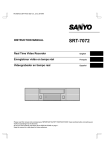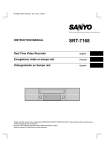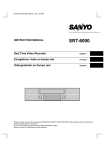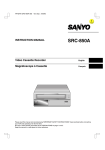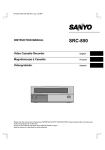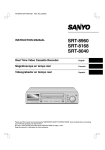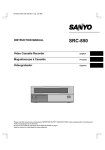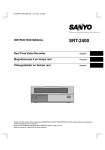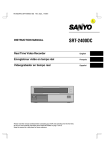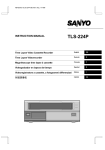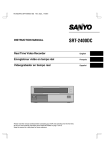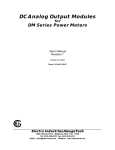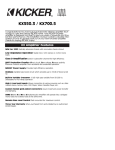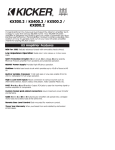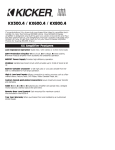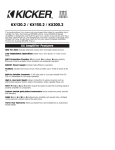Download Fisher TLS-9960 User's Manual
Transcript
RC4Q/U (TLS-9960 GB) Mon. Aug., 23/1999 INSTRUCTION MANUAL TLS-9960 Time Lapse Video Cassette Recorder English Magnétoscope time lapse à cassette Français Videograbador en lapsos de tiempo Español Please read this manual and accompanying “IMPORTANT SAFETY INSTRUCTIONS” sheet carefully before connecting your VCR and operating it for the first time. Be sure to read carefully and follow all the PRECAUTIONS on page 1. Keep the manual in a safe place for future reference. RC4Q/U (TLS-9960 GB) Mon. Aug., 23/1999 PRECAUTIONS The lightning flash with arrowhead symbol, within an equilateral triangle, is intended to alert the user to the presence of uninsulated “dangerous voltage” within the product’s enclosure that may be of sufficient magnitude to constitute a risk of electric shock to persons. CAUTION RISK OF ELECTRIC SHOCK DO NOT OPEN CAUTION: TO REDUCE THE RISK OF ELECTRIC SHOCK, The exclamation point within an equilateral triangle is intended to alert the user to the presence of important operating and maintenance (servicing) instructions in the literature accompanying the product. DO NOT REMOVE COVER (OR BACK). NO USER-SERVICEABLE PARTS INSIDE. REFER SERVICING TO QUALIFIED SERVICE PERSONNEL. This equipment has been tested and found to comply with the limits for a Class B digital device, pursuant to Part 15 of the FCC Rules. These limits are designed to provide reasonable protection against harmful interference when the equipment is operated in a commercial environment. This equipment generates, uses, and can radiate radio frequency energy and, if not installed and used in accordance with the instruction manual, may cause harmful interference to radio communications. Operation of this equipment in a residential area is likely to cause harmful interference in which case the user will be required to correct the interference at his own expense. WARNING: To reduce the risk of fire or electric shock, do not expose this appliance to rain or other moisture. CAUTION: Changes or modifications not expressly approved by the manufacturer may void the user’s authority to operate this equipment. For the customers in Canada This class B digital apparatus complies with Canadian ICES-003. Declaration of Conformity Location Model Number Trade Name Responsible party Address For safe operation and satisfactory performance of your VCR, keep the following in mind when selecting a place for its installation: œ Shield it from direct sunlight and keep it away from sources of intense heat. Telephone No. : : : : TLS-9960 SANYO SANYO FISHER COMPANY 21605 Plummer Street, Chatsworth, California 91311 : (818) 998-7322 œ This device complies with Part 15 of the FCC Rules. Operation is subject to the following two conditions: (1) this device may not cause harmful interference, and (2) this device must accept any interference received, including interference that may cause undesired operation. œ Avoid dusty or humid places. œ Avoid places with insufficient ventilation for proper heat dissipation. Do not block the ventilation holes of the VCR. Do not place the unit on a carpet because this will block the ventilation holes. œ Install the VCR in a horizontal position only. œ Avoid locations subject to strong vibrations. œ Avoid moving the VCR between cold and hot locations (see “Moisture Condensation Problems”, this page). Moisture Condensation Problems œ Do not place the VCR directly on top of the TV, as this may cause playback or recording problems. Cause: œ Do not handle the power cord with wet hands. When the VCR is first installed, moved from a cold area to a warm area or placed in a location with high humidity, dew (moisture) may form in the unit. The Dew indicator (À) blinks. If you operate the VCR with dew inside, damage may result. œ Do not pull on the power cord when disconnecting it from an AC wall outlet. Grasp it by the plug. Prevention: œ If any liquid is spilled on the VCR, unplug the power cord immediately and have the unit inspected at a factory-authorized service center. 1 Make all necessary connections. 2 Plug the power cord into a 120 V AC wall outlet. 3 Do not operate the VCR for approximately 2 hours. Avoiding Electrical Shock and Fire œ Do not place anything directly on top of this VCR. English When the VCR reaches room temperature, the Dew indicator (À) will turn off and the VCR will be ready to operation. 1 RC4Q/U (TLS-9960 GB) Mon. Aug., 23/1999 FEATURES CONTENTS œ Tape management function œ JOG/SHUTTLE operation œ Can also be controlled through an RS-232C or RS-485 connection œ Clog detection œ High-speed Fast Forward/Rewind œ Field recording/playback œ 2, 12, 24, 48, 72, 96, 120, 168, 240, 360, 480, 720 and 960-hour mode recording œ In 2, 12, 24-hour modes audio recording is available œ Autorepeat recording œ Series recording function œ Alarm recording function œ Single image recording function œ On-screen mode setting œ Integrated time date generator œ Day/Time search function œ Alarm scan/search function œ Forward/Reverse frame advance function œ 30-day memory backup œ Security lock œ Recording check function œ Automatic head cleaning function œ Head switching function PRECAUTIONS . . . . . . . . . . . . . . . . . . . . . . . . . . . . . . . 1 FEATURES . . . . . . . . . . . . . . . . . . . . . . . . . . . . . . . . . . . 2 ACCESSORY . . . . . . . . . . . . . . . . . . . . . . . . . . . . . . . . . 2 LOCATIONS OF CONTROLS AND INDICATORS. . . . . . . . . . . . . . . . . . . . . . . . . . . . . . 3 CONNECTIONS . . . . . . . . . . . . . . . . . . . . . . . . . . . . . . . 6 TYPES OF ON-SCREEN DISPLAYS AND DISPLAY SEQUENCE . . . . . . . . . . . . . . . . . . . . . . 7 SETTING THE LANGUAGE AND CLOCK . . . . . . . . . . . 9 CHANGING THE ON-SCREEN DISPLAY . . . . . . . . . . 10 VIDEO CASSETTE TAPES . . . . . . . . . . . . . . . . . . . . . 11 TAPE MANAGEMENT FUNCTION . . . . . . . . . . . . . . . 13 NORMAL RECORDING . . . . . . . . . . . . . . . . . . . . . . . . 16 AUTOREPEAT RECORDING. . . . . . . . . . . . . . . . . . . . 19 ALARM RECORDING. . . . . . . . . . . . . . . . . . . . . . . . . . 20 PROGRAM TIMER RECORDING . . . . . . . . . . . . . . . . 23 RECORDING USING AN EXTERNAL TIMER INPUT . . . . . . . . . . . . . . . . . . 27 SERIES RECORDING . . . . . . . . . . . . . . . . . . . . . . . . . 28 SINGLE IMAGE RECORDING . . . . . . . . . . . . . . . . . . . 30 NORMAL PLAYBACK. . . . . . . . . . . . . . . . . . . . . . . . . . 31 ACCESSORY SPECIAL PLAYBACK. . . . . . . . . . . . . . . . . . . . . . . . . . 32 TAPE COUNTER . . . . . . . . . . . . . . . . . . . . . . . . . . . . . 34 Power cord SETTING THE SECURITY LOCK . . . . . . . . . . . . . . . . 34 SETTING THE BUZZER. . . . . . . . . . . . . . . . . . . . . . . . 35 CLOCK ADJUSTMENT . . . . . . . . . . . . . . . . . . . . . . . . 35 SETTING THE RS-232C OR RS-485 DATA TRANSFER SPEED . . . . . . . . . . . . . . . . . . 36 CHECKING POWER FAILURE, FAILURE DUE TO CONDENSATION AND USAGE DURATION . . . . . . . . . . . . . . . . . . . . . . . 37 OUTPUT TERMINALS . . . . . . . . . . . . . . . . . . . . . . . . . 38 HEADS SWITCHING FUNCTION . . . . . . . . . . . . . . . . 41 MAINTENANCE . . . . . . . . . . . . . . . . . . . . . . . . . . . . . . 42 TROUBLESHOOTING GUIDE . . . . . . . . . . . . . . . . . . . 44 SPECIFICATIONS . . . . . . . . . . . . . . . . . . . . . . . . . . . . 45 WARRANTY . . . . . . . . . . . . . . . . . . . . . . . . . . . . . . . . . 46 2 English RC4Q/U (TLS-9960 GB) Mon. Aug., 23/1999 LOCATIONS OF CONTROLS AND INDICATORS Front Panel 12 3 4 5 6 7 8 9F REC/PLAY l SPEED j » l « COUNTER RESET MEMORY STILL PAUSE ON ALARM SPEED DURATION 2H 20S 12H PROG. NC CC SOFT SHARP MENU RESET WV SEARCH AUDIO ON POWER STOP a REC i EJECT REPEAT ALL RESET U TSRQ I P O N M 1 TIMER button 2 COUNTER RESET button 3 SHIFT ] or « (display position down or right) button 4 COUNTER MEMORY button 5 REC/PLAY SPEED l or j (decrease or increase L K J I M Digital display panel N POWER indicator O REPEAT (autorepeat recording) indicator P REC (record) button Q REPEAT REC (autorepeat recording) switch R ALARM DURATION (alarm recording time) switch S ALARM SPEED (alarm recording speed) switch T ON SCREEN switch U ALL RESET button V MENU RESET button W SHARPNESS control recording/playback speed mode) button 6 TRACKING/V. STILL – or + button 7 Cassette loading slot 8 PLAY (REC CHECK) button 9 STILL/PAUSE button F JOG dial G SHUTTLE ring H MENU button I Front door J SEARCH/AUDIO ON button K STOP button L EJECT button English FF ON MENU » JOG , j TRACKING – V.STILL + REPEAT REC ON SCREEN OFF OFF SHARPNESS l SHUTTLE j PLAY (REC CHECK) REW TIMER ] SHIFT « GH NOTE: œ Buttons 3 and 5 are also used for menu control. 3 RC4Q/U (TLS-9960 GB) Mon. Aug., 23/1999 LOCATIONS OF CONTROLS AND INDICATORS 5 Mode display Digital Display 1 2 3 4 œ Recording/playback speed mode 5 œ Alarm search mode œ Alarm scan mode OFF E M H G F9 8 M œ Dew display S 7 6 1 Operation Indicators 5, 6 Mode display œ They display the actual operation mode. Operation Mode Record (REC) œ Day/Time search mode Indicator Record pause (REC PAUSE) Playback (PLAY) 6 Counter display Still image (STILL) œ Time display Fast forward (FF) Rewind (REW) œ Linear time counter display Forward picture search Reverse picture search H Reverse playback 7 OFF indicator Field shift forward M S OFF Comes on when the tape end has been reached after a recording, except during autorepeat recording mode. Field shift backward M 8 Counter memory indicator œ Clog detection indicator Flashes when the recording quality deteriorates due to dirty VCR heads. Comes on when the counter memory function is engaged. 9 Timer Recording indicator 2 Cassette indicator Comes on when in timer recording stand-by mode, or during a timer recording. Comes on when a cassette is loaded. 3 Alarm indicator F Security lock indicator Flashes when an alarm is being recorded: Comes on when the security lock is engaged. G External input indicator Comes on after the alarm has been recorded: E Comes on when recording using the EXT TIMER IN input terminal. 4 Power failure indicator Comes on after a power failure. 4 English RC4Q/U (TLS-9960 GB) Mon. Aug., 23/1999 LOCATIONS OF CONTROLS AND INDICATORS Back Panel 1 2 A 3 H EXT WARNING TAPE TIMER IN COM OUT END OUT RS485 CLOCK SET OUT IN ADDRESS 485 TERMINATE ON ON OFF SW OUT COM COM TIMER OUT ALARM OUT IN B 232 SERIES OUT/ SERIES NON REC OUT IN 1 SHOT ALARM IN RESET IN PUSH OPEN OFF AUDIO REMOTE MIC IN IN VIDEO OUT IN OUT AC IN ~ RS232C X W Pin locations (femele) on the VCR Pin locations (male) on the VCR V U TS R Q 4 56 789 FG WARNING TAPE EXT OUT END OUT TIMER IN COM 1 6 6 COM TIMER OUT ALARM OUT IN SERIES OUT/ SERIES NON REC OUT IN 1 SHOT ALARM IN RESET IN 9 NOTE: Do not connect to phone line. P ON M LKJ I 1 RS485 A connector (RJ11 type) 2 RS485 B connector (RJ11 type) 3 DIP switches NOTE: This terminal board may be damaged by 5kg-cm or more torque and using φ6mm-tip or more size screwdrivers. K TIMER OUT (timer recording output) terminal L COM (common) terminal M SERIES IN (series recording trigger input) terminal N SERIES OUT/NON REC OUT (series recording œ Used when controlling the VCR through the RS485 or the RS232C connectors. trigger output/non recording output) terminal 4 EXT TIMER IN (external timer input) terminal 5 COM (common) terminal 6 WARNING OUT (warning output) terminal 7 TAPE END OUT (tape end output) terminal 8 SW OUT (switch output) terminal 9 COM (common) terminal F ALARM OUT (alarm output) terminal G ALARM IN (alarm input) terminal H Battery compartment I ALARM RESET IN (alarm reset input) terminal J 1 SHOT IN (single image recording trigger input) O CLOCK SET IN (external clock set trigger input) terminal P CLOCK SET OUT (external clock set trigger output) terminal Q VIDEO OUT (video output) jack R VIDEO IN (video input) jack S AUDIO OUT (audio output) jack T AUDIO IN (audio input) jack U MIC IN (microphone input) jack V REMOTE (remote control input) jack W RS232C connector (D-sub 9-pin type) X AC power input terminal English COM 5 CLOCK SET OUT IN 1 SW OUT 5 RC4Q/U (TLS-9960 GB) Mon. Aug., 23/1999 CONNECTIONS Connect the video camera and monitor TV as shown in the figure below. NOTE: Before making the connections, make sure the devices are disconnected from the power outlet. Monitor TV (sold separately) Video camera (sold separately) To VIDEO IN jack From an external audio source A EXT WARNING TAPE TIMER IN COM OUT END OUT RS485 ADDRESS 485 TERMINATE ON ON OFF SW OUT COM COM TIMER OUT ALARM OUT IN B 232 CLOCK SET OUT IN SERIES OUT/ SERIES NON REC OUT IN 1 SHOT ALARM IN RESET IN PUSH OPEN OFF AUDIO REMOTE MIC IN IN OUT VIDEO IN OUT AC IN ~ RS232C Power cord To outlet To VIDEO OUT jack To remote control (sold separately) Coaxial cable (sold separately) Power Cord Installation NOTES: 1 Plug the supplied power cord firmly into the AC power 2 Insert the plug of this power cord into a outlet. œ For more details, please refer to the manuals accompanying all other devices. If the connections are not made properly, it may cause a fire or damage the equipment. About the memory reset œ You can use a VA-RMN01 Remote Control Unit (sold separately) to control remotely the VCR. If the VCR location is changed or to cancel previous settings, please reset the memory as described below. œ The grounded power cord (3 pin plug) must be connected to a grounded power outlet. All the settings as the time and date will be reset, and the security lock will be cancelled. œ If there is no video signal when the power is turned on, “NO VIDEO” will be displayed on-screen. input AC IN ~ socket. To reset the memory, press the ALL RESET button. 6 English RC4Q/U (TLS-9960 GB) Mon. Aug., 23/1999 TYPES OF ON-SCREEN DISPLAYS AND DISPLAY SEQUENCE Reference pages are shown in square brackets. Monitor TV screen (normal screen) TAPE MANAGEMENT menu [13-15] <TAPE MANAGEMENT> 10-15-99 FRI 000 15:20:00 2 DTo set the tape management function Set the ON SCREEN switch to the “ON” position Press the MENU button Press the MENU button SET UP 1 menu Press the MENU button TIMER SET menu Press the MENU button [10, 35] Press the MENU button SET UP 3 menu [20, 35, 12, 19, 38, 18, 28, 36] Press the MENU button <SET UP 4> <ALARM TIME> Press the MENU button Press the SEARCH/AUDIO ON button DTo set various VCR function <POWER FAILURE> <USED TIME> English [21] DTo display the number, date and time of the alarm recordings Press the SEARCH/AUDIO ON button POWER FAILURE/DEW/ [37] USED TIME menu [39, 12, 17, 30] <DEW> Press the MENU button Press the SEARCH/AUDIO ON button ALARM TIME menu DTo set various VCR functions SET UP 4 menu DTo set the holidays <HOLIDAY SET> Press the SEARCH/AUDIO ON button <SET UP 3> Press the SEARCH/AUDIO ON button HOLIDAY SET menu [25] DTo set various VCR functions <SET UP 2> [23-27] DTo set timer recordings <TIMER SET> Press the SEARCH/AUDIO ON button SET UP 2 menu Press the MENU button [9, 28, 39, 40] DTo set various VCR functions <SET UP 1> Press the SEARCH/AUDIO ON button Press the MENU button Press the SEARCH/AUDIO ON button 7 DTo display the number and duration of power failures DTo display the number and duration of failures due to condensation DTo display the time used Press the SEARCH/AUDIO ON button RC4Q/U (TLS-9960 GB) Mon. Aug., 23/1999 TYPES OF ON-SCREEN DISPLAYS AND DISPLAY SEQUENCE NOTES: Using the JOG dial and SHUTTLE ring œ When a menu is displayed, recording will not be possible. JOG dial œ Press the SEARCH/AUDIO ON or MENU button, the setting procedure is now completed. œ Put the tip of your index finger into the depression then turn the dial in any direction. œ During recording or playback the menus cannot be displayed. œ When a menu is displayed, turn the dial clockwise and the cursor will move to the right (or down). Turn the dial counterclockwise and the cursor will move to the left (or up). œ To reset the settings of a menu to their original values, select the desired menu then press the MENU RESET button. The (USED TIME) menu data cannot be reset. SHUTTLE ring œ To enter the settings use the JOG dial or SHUTTLE ring. œ When a menu is displayed, turn the ring of 10° or more clockwise and the selected data setting will change or the selected setting value will increase. Turn the ring of 10° or more counterclockwise and the selected data setting will change or the selected setting value will decrease. œ If held for 1 second or more the changes will be made sequentially. 8 English RC4Q/U (TLS-9960 GB) Mon. Aug., 23/1999 SETTING THE LANGUAGE AND CLOCK 5 Turn the SHUTTLE ring to set the month the daylight Language Setting saving time adjustment is made, then turn the JOG dial clockwise. English, French or Spanish can be selected by the user. 1 Turn the power on to all devices used. 2 Press the MENU button to display the (SET UP 1) 01, 02,.....11, 12 (for January, February......November, December) 6 Turn the SHUTTLE ring to set the time the daylight menu. saving time adjustment is made. @@@@@@@<SET@UP@1> öDAYLIGHT@SET@@@@@NO@USE @@@@@@@@WEEK@MONTH@TIME @ON@@@1ST-SUN@@04@02:00 @OFF@@LST-SUN@@10@02:00 öOUTPUT@@@@@@@@SERIES öCLOCK@SET @01-01-00@SAT@@00:00:00 öREMOTE@@@@@@@@EJECT öLANGUAGE-LANGUE-IDIOMA @@@ENGLISH 7 Turn the JOG dial clockwise, until “LST” is flashing. 8 Following the same procedure as above (steps 4 to 6), set when the time is changed back from daylight saving time to standard time. 3 Turn the JOG dial, until “ENGLISH” is flashing. 4 Turn the SHUTTLE ring to select the language of 9 Turn the JOG dial clockwise, until the “CLOCK SET” setting is flashing. F Turn the SHUTTLE ring to set the month (ex: 10), your choice. then turn the JOG dial clockwise. 5 Press the SEARCH/AUDIO ON button to save the ø The day of week is set automatically. setting. G Turn the SHUTTLE ring to set the day (ex: 15), then Clock setting turn the JOG dial clockwise. H Turn the SHUTTLE ring to set the year (ex: 99 for Example: To set the clock to October 15, 1999 at 3:20 PM (15:20). 1999), then turn the JOG dial clockwise. 1 Press the MENU button to display the (SET UP 1) ø The last 2 digits only are displayed. I Turn the SHUTTLE ring to set the hours (ex: 15 for 3 menu. 2 Turn the SHUTTLE ring, to set the auto daylight PM), then turn the JOG dial clockwise. J Turn the SHUTTLE ring to set the minutes (ex: 20), saving time/standard time adjustment. then turn the JOG dial clockwise. NO USE . . . . No daylight saving time/standard time adjustment is made. @@@@@@@<SET@UP@1> öDAYLIGHT@SET@@@@@USE @@@@@@@@WEEK@MONTH@TIME @ON@@@1ST-SUN@@04@02:00 @OFF@@LST-SUN@@10@02:00 öOUTPUT@@@@@@@@SERIES öCLOCK@SET @10-15-99@FRI@@15:20:00 öREMOTE@@@@@@@@EJECT öLANGUAGE-LANGUE-IDIOMA @@@ENGLISH USE . . . . . . . The auto daylight saving time/ standard time adjustment is made. 3 Turn the JOG dial clockwise, until “1ST” is flashing. 4 Set the day the daylight saving time adjustment is made. K For accurate clock setting, turn the SHUTTLE ring œ Turn the SHUTTLE ring to set the week, then turn the JOG dial clockwise. counterclockwise timed with a time broadcast, or other accurate time signal, this will start the seconds counting from 00. 1ST, 2ND, 3RD, 4TH or LST (first, second, third, fourth or last) L Press SEARCH/AUDIO ON button. œ Turn the SHUTTLE ring to set the day of week, then turn the JOG dial clockwise. ø The setting procedure is now completed. NOTES: SUN, MON, TUE, ...... SAT (Sunday, Monday, Tuesday....Saturday) œ Clock display is only 24 hours. œ In STOP mode, press and hold the STOP button then press the TRACKING/V.STILL– button to reset the minutes and seconds to 00 (to the closest hour). For example, between 13:30:00 and 14:29:59 the clock is reset to 14:00:00. English 9 RC4Q/U (TLS-9960 GB) Mon. Aug., 23/1999 CHANGING THE ON-SCREEN DISPLAY Selecting the On-screen Display Changing the Date/Time Display Position You can select to display or not the date, time, the number of alarm recordings and tape speed. 1 Turn the power on to all input devices to the VCR. 2 Set the ON SCREEN switch to the “ON” position. 1 Turn the power on to all devices used. 2 Press the MENU button until the (SET UP 2) menu is ø The date and time are displayed. 10-15-99@FRI@000 15:20:00@@@2 displayed. @@@@@@@<SET@UP@2> öDISPLAY @@@DATE@@@@@@@@@@@Y @@@TIME@@@@@@@@@@@Y @@@ALARM@COUNT@@@@Y @@@SPEED@@@@@@@@@@Y öBUZZER @@@ALARM@IN@@@@@@@Y @@@TAPE@END@@@@@@@Y @@@KEY@IN@@@@@@@@@N @@@WARNING@@@@@@@@Y 3 Press the SHIFT « (or ]) button. ø The display will move towards the right (or the bottom). 3 Turn the JOG dial clockwise, until the desired item for which the display function will be set is flashing. 4 Turn the SHUTTLE ring to set “Y” for the functions NOTES: described below. œ If the SHIFT « (or ]) button is kept pressed for 1 second or more the display will move at a faster speed. DATE . . . . . . . . . . . . The date is displayed œ The display position cannot be changed while recording. TIME . . . . . . . . . . . . The time is displayed ALARM COUNT. . . . The number of alarm recordings is displayed SPEED. . . . . . . . . . . The recording/playback speed mode is displayed 5 Press the SEARCH/AUDIO ON button to save the settings. NOTE: œ If the ON SCREEN switch is set to the “ON” position, the items for which “Y” is set are recorded. The items for which “N” was set at step 4 above are not recorded. 10 English RC4Q/U (TLS-9960 GB) Mon. Aug., 23/1999 VIDEO CASSETTE TAPES Use only video cassette tapes bearing the w logo. This VCR was primarily designed for use with T-120 cassette tapes, it is recommended to use T-120 standard grade VHS video cassette tapes for optimal performance. Loading 1 Place the cassette, label side up, in the loading slot. Gently push the center of the cassette until it is loaded automatically. Handling Cassette Tapes The cassette tapes should always be stored vertically, in their cases, away from high temperatures, magnetic fields, direct sunlight, dirt, dust and locations subject to mold formation. Do not tamper with the cassette mechanism and never touch the tape with your fingers. ø The time display will switch to the reset counter “0:00:00” display. Protect the cassette tapes from shocks or strong vibrations. ø After the cassette tape is loaded, a mechanism will operate for about 5 seconds to check that the tape has been threaded correctly and the cassette indicator “o” will blink during that period. To Protect your Recordings After having recorded a tape, if you wish to keep the recording, use a flathead screwdriver to break off the erasure-prevention tab on the cassette. ø When the cassette is loaded, if the tape has been threaded correctly, the cassette indicator “o” will light on the digital display. To record again on a tape without erasure-prevention tab, cover the hole with adhesive tape. NOTE: œ If you try to record on a cassette without erasure-prevention tab, the VCR will eject the cassette. Unloading 1 In stop mode, press the EJECT button. Erasure-prevention tab ø The cassette is automatically ejected. NOTES: Precautions concerning the video cassette tapes œ Do not insert any object in the cassette loading slot, as that may cause injury and damages to the VCR. œ Do not use tapes that are damaged, tapes that have been cut and repaired or tapes that have been altered in any way. œ If your hand gets stuck in the cassette loading slot, unplug the power cord and consult the dealer where the unit was bought. Do not forcibly pull the hand out as that may cause severe injuries. œ Some rewinders may entangle the tape, and therefore their use is not recommended. œ When tapes are recorded over and over again, the recording quality will deteriorate. Refer to “Concerning the Number of Times Tapes can be Rerecorded on” on page 17, and replace the tape with a new tape as required. English 11 RC4Q/U (TLS-9960 GB) Mon. Aug., 23/1999 VIDEO CASSETTE TAPES Correct tape thread check function Setting the Action to Take When a Cassette is Loaded If the correct tape thread check function is on, after the cassette tape is loaded, a mechanism will operate for about 5 seconds to check that the tape has been threaded (loaded) correctly and the cassette indicator “o” will blink during that period. If the tape is not loaded properly, the cassette will be ejected. In the (SET UP 3) menu, you can set the mode the VCR will go into when a cassette is loaded. 1 Press the MENU button until the (SET UP 3) menu is displayed. @@@@@@@<SET@UP@3> öALARM@MODE@@@@@@@Y1 öALARM@DURATION@@@20S NOTES: œ This function checks to make sure that the cassette has been correctly loaded. It is recommended to use this function to make sure the recordings are conducted reliably. öEXT@TIME@ADJ.@@@@01:00 öTAPE@IN@MODE@@@@@STOP öTAPE@END@MODE@@@@REW öTAPE@END@OUT@@@@@-3M öCLOG@DETECT.@@@@@Y öSERIES@REC@IN@@@@N öRS-232C@@@@@@@@@@19200 œ If during the tape thread check operation, the REC, PLAY or STOP button is pressed or if the SHUTTLE ring is turned, the command will only be executed after the tape thread has been checked. Only the EJECT button will operate while the tape thread is being checked. 2 Turn the JOG dial, until the “TAPE IN MODE” setting is flashing. 3 Turn the SHUTTLE ring, to set the desired mode. STOP . . . . . . Stays in stop mode REC . . . . . . . Goes into recording mode œ If in the (SET UP 3) menu “TAPE IN MODE” is set to “REC”, the recording indicator “m” will light during the while the tape thread is checked. However, recording will only start after the tape thread check is completed. To cancel recording, press the STOP button. 4 Press the SEARCH/AUDIO ON button to save the setting. 1 Press the MENU button until the (SET UP 4) menu is displayed. @@@@@@@@<SET@UP@4> öSW@OUT @@FIELD@@@@@@@@@01 @@TIMING@@@@@@@@FIELD @@2H@@@@@@@@@@@@Y öTHREAD@CHECK@@@Y öVIDEO@LOSS@@@@@N öREC@SPEED@@@@@@N ö1@SHOT@SET @@FIELD@@@@@@@@@1 @@INTERVAL@@@@@@1M 2 Turn the JOG dial, until the “THREAD CHECK” setting is flashing. 3 Turn the SHUTTLE ring, to set the desired mode. Y . . . . . . . . . The correct tape thread check function is on N . . . . . . . . . The correct tape thread check function is off 4 Press the SEARCH/AUDIO ON button to save the setting. 12 English RC4Q/U (TLS-9960 GB) Mon. Aug., 23/1999 TAPE MANAGEMENT FUNCTION After the tape management data is checked, if there is no conflict, recording starts and the data at the beginning of the tape is updated. The message “T. MANAGE. OK” is displayed on-screen while the data is updated. This VCR is equipped with a tape management function. Using this function you can protect previous recordings and prevent overuse of the tape by controlling the tape protection term (number of days), the maximum number of re-recordings of the tape and the recording group. To use the tape management function, it must be set before recording is started. The tape management data is recorded at the beginning of the tape. For details on how to set this function, refer to “Setting the Tape Management Function”. If a conflict is found when the tape management data is checked, the (TAPE MANAGEMENT) menu is displayed and the conflicting setting will flash. This menu will show the settings taken from the data recorded on the tape and not the current data settings held in the VCR’s (TAPE MANAGEMENT) menu setting. Refer to “Tape Management Conflict Display” for detailed information. NOTE: œ Before using this function, make sure that the clock is set properly. NOTES: œ During Autorepeat recording, the tape management data at the beginning of the tape will be checked and updated every time the tape is rewound to the beginning. However, the “PROTECT DAY” setting will be ignored. Also, even if there is a conflict with the “REC PASS SET” number, autorepeat recording will continue without any warning. Operation When recording is started, the VCR will rewind the tape to the beginning to check for the presence of tape management data. The message “T. MANAGE. CHK” will be displayed. œ If an alarm trigger is received while the tape management data is being set or checked, in order not to corrupt the data, the tape is advanced of a preset duration, then the alarm recording is conducted according to the alarm settings. Furthermore, when setting a program timer recording, in order to protect the data, no alarm trigger will be received until the first program timer recording starts. NOTES: œ When a program timer recording is set, the tape management data is checked after the TIMER button is pressed to complete the program timer recording setting. œ When performing a single image recording, the tape management function will not operate even if it is active. If no tape management data is present on the tape IMPORTANT NOTES: œ If the tape management data cannot be read, the VCR will switch to stop mode and “INCORRECT DATA” will be displayed on-screen. This may indicate that the beginning of the tape (data recording/reading section) is damaged and the tape may be unusable. The message “INCORRECT DATA” will disappear when the EJECT, STOP or PLAY button is pressed. If the tape has already been recorded on: The recording will start using the settings of the (TAPE MANAGEMENT) menu. The message “USED TAPE” will flash on-screen until recording starts. If the tape is new: The recording will start using the settings of the (TAPE MANAGEMENT) menu. œ Set the security lock function to on in order to protect the security of this feature. If tape management data is present on the tape The tape management data is checked and if there is no conflict, recording can be performed. If there is conflict that prevents recording, the VCR will go into stop mode, the (TAPE MANAGEMENT) menu is displayed and the conflicting setting that is preventing recording will flash. English 13 RC4Q/U (TLS-9960 GB) Mon. Aug., 23/1999 TAPE MANAGEMENT FUNCTION 6 Turn the SHUTTLE ring, to select the desired number Setting the Tape Management Function of re-recording times. 1 Press the MENU button until the (TAPE OFF . . . . The number of re-recording times will not be checked. MANAGEMENT) menu is displayed. ø The “TAPE MANAGE.” setting is flashing. 1-100 . . . Maximum number of re-recording times. @@@@<TAPE@MANAGEMENT> öTAPE@MANAGE.@@@@N öPROTECT@DAY@@@@@30 (Refer to “Concerning the Number of Times Tapes can be Rerecorded on” on page 17.) öREC@PASS@SET@@@@10 NOTES: öGROUP@NO.@@@@@@@OFF œ The data is updated at the beginning of the recording. Even if the recording is stopped before the end, the original data will remain unchanged. öOVERRIDE@@@@@@@@N 2 Turn the SHUTTLE ring, to select the desired mode. N . . . . . . The tape management function is not active. œ During Autorepeat recording, the re-recording times count will be updated every time the tape is rewound to the beginning. Autorepeat recording will proceed even if the count exceeds the “REC PASS SET” setting. If in the BUZZER section WARNING is set to “Y”, the buzzer is heard. Y. . . . . . . The tape management function is active. When setting to “Y”, please continue with the settings below. 3 Turn the JOG dial, until the “PROTECT DAY” setting 7 Turn the JOG dial, until the “GROUP NO.” setting is is flashing. flashing. 4 Turn the SHUTTLE ring, to select the desired number 8 Turn the SHUTTLE ring, to select the desired group of days to protect the tape. number. OFF . . . . The tape is not protected. OFF . . . . The group number will not be checked. 1-255 . . . Number of days to protect the tape (prevent over-recording), from the date of the last recording on the tape (or the last expected recording date (calculated using the tape length (T-120) and the recording speed). 1-15 . . . . Group number setting. 9 Turn the JOG dial, until the “OVERRIDE” setting is flashing. F Turn the SHUTTLE ring, to select the desired override mode. NOTES: Y . . . . . . . In case of a conflict that prevents recording, the next operation is executed. If recording is done, then the last recording date and the re-recording times count are updated. œ Since the last expected recording date is a calculated date (using the tape length (T-120) and the recording speed), it may be different from the actual last recording date, this due to other settings such as (alarm recordings, program timer recordings, holiday settings). N. . . . . . . In case of a conflict that prevents recording, the (TAPE MANAGEMENT) menu is displayed and the conflicting setting preventing recording will flash. The only possible action is to press the EJECT button, in order to eject the tape. (Refer to “Tape Management Conflict Display”.) œ When setting a program timer recording, the tape protection term is checked when the VCR is set to program timer recording stand-by mode. œ When a program timer recording is done, the data is updated when recording starts. Even if the recording is stopped before the programmed time, the original data (last expected recording date) will remain as calculated. G Press the SEARCH/AUDIO ON button to save the settings. 5 Turn the JOG dial, until the “REC PASS SET” setting NOTES: is flashing. œ Once the tape management data is recorded on tape, it cannot be changed. œ The criteria (condition) for allowing recording will be based on the data recorded on the tape and not the settings in the (TAPE MANAGEMENT) menu. 14 English RC4Q/U (TLS-9960 GB) Mon. Aug., 23/1999 TAPE MANAGEMENT FUNCTION PROTECT DAY CONFLICT Tape Management Conflict Display The tape is protected, the tape protection term (ex. 30 days) is not yet over. If when the tape management function checks the tape data a conflict that prevents recording is found, the (TAPE MANAGEMENT) menu is displayed with the conflicting setting flashing and the VCR go into the stop mode. If in the (SET UP 2) menu, in the BUZZER section WARNING is set to “Y”, the buzzer is heard. (To stop the buzzer, press the STOP button.) Under LAST M/D, the date of the last recording on the tape (or the last expected recording date (calculated using the tape length (T-120) and the recording speed)) is displayed. Under NEXT M/D, the date when it will be possible to record on the tape again is displayed. NOTES: œ If “OVERRIDE” is set to “N” (No), the conflicting setting is displayed flashing and the message (PRESS EJECT) is displayed at the bottom of the screen. Recording under these conditions is not possible. Press the EJECT button to eject the tape. To record on the same tape, set the OVERRIDE setting to “Y” and modify the conflicting setting, then insert the same tape and press the REC button. However, if only “PROTECT DAY” and “REC PAS SET” are modified, the menu will be displayed again. Press the REC button one more time to start recording. Recording starts and the tape data is updated. REC PASS SET CONFLICT The set number of recording passes has been exceeded. The PASS COUNT shows the number of recording passes on the tape (ex. this would be the 11th time the tape is recorded over, since the maximum recording passes number is set to “10”, this prevents recording.) NOTES: œ When conducting Autorepeat recording, if the PASS COUNT exceeds 100, “101ö” will be displayed flashing. Conflict display sample œ If using a tape recorded previously on a different type of VCR (no tape data), when the set number of recordings is exceeded, “USED TAPE” will flash next to the PASS COUNT number. @@@@<TAPE@MANAGEMENT> öTAPE@MANAGE.@@@@N öPROTECT@DAY@@@@@30 @LAST@M/D@@@@@@@@NEXT@M/D @@@@@12/15@@@@@@@@@@@@1/16 öREC@PASS@SET@@@@10 @PASS@COUNT@@@@@@11 öGROUP@NO.@@@@@@@7 @[email protected].@@@@@@8 öOVERRIDE@@@@@@@@N @@@@@@(PRESS@EJECT) GROUP NO. CONFLICT The group numbers do not match. The REC GR. NO. shows the tape recording group number (ex. this tape belongs to a different recording group number 8 than the one set 7.) œ If the “OVERRIDE” is set to “Y” (Yes), the (TAPE MANAGEMENT) menu is displayed and conflicting setting preventing recording will flash and VCR go into the stop mode. To enter the record mode, press the REC button. English 15 RC4Q/U (TLS-9960 GB) Mon. Aug., 23/1999 NORMAL RECORDING [Recording Speed Mode] Normal Recording Maximum Recording recording speed mode duration (with a (hour mode) T-120 cassette tape) (hours) 2 2 12 14 24 26 48 50 72 74 96 98 120 122 168 170 240 242 360 362 480 482 720 722 960 962 000 — Before starting œ Turn the power on to all devices used. œ Load a cassette tape with erasure-prevention tab. NOTE: œ If in the (SET UP 3) menu, TAPE IN MODE is set to “REC”, recording will start after the tape thread has been checked. œ Set the ON SCREEN switch to the “ON” position. 1 Press the REC/PLAY SPEED l (or j) button to set the recording speed mode. ø The recording speed mode is displayed on-screen and on the digital display. Recording interval (second) 1/60 7/60 13/60 25/60 37/60 49/60 61/60 85/60 121/60 181/60 241/60 361/60 481/60 60-180 Audio recording Tape motion Possible Continuous Not possible Intermittent Record Pause 2 Press the REC button. Recording can be interrupted temporarily. 1 Press the STILL/PAUSE button during recording. ø The Pause/Still indicator “N” blinks. ø The record indicator “m” light. ø Recording starts. ø When the end of the tape is reached, “OFF” will be displayed. NOTES: œ The image appears on-screen but it is not recorded. NOTES: œ If a recording pause continues for 5 minutes or more, the VCR will go into stop mode to avoid damaging the tape. œ If in the (SET UP 2) menu, in the BUZZER section TAPE END is set to “Y”, the buzzer will be heard as long as “OFF” is displayed on the digital display. 2 To resume recording, press the REC button, or press œ To cancel the “OFF” display, press the STOP, EJECT or PLAY button or turn the SHUTTLE ring. the STILL/PAUSE button again. œ If recording stops due to a problem with the tape or other reason, the unit will try once to resume recording. If the tape still does not advance, the VCR will go into stop mode. 3 To stop recording, press the STOP button. NOTES: œ A tape recording made on this VCR may not play back with the same degree of clarity on a time lapse from another manufacturer. œ If you press on the REC button and the loaded cassette has no erasure-prevention tab, the VCR will eject the cassette. 16 English RC4Q/U (TLS-9960 GB) Mon. Aug., 23/1999 NORMAL RECORDING Concerning the Number of Times Tapes can be Rerecorded on Changes to the Recording Speed Mode During Recording Depending on the recording speed mode, the tape must be replaced after a certain number of recording times. It is possible to permit or prevent changing the recording speed mode during recording. Refer to the table below for the maximum number of times a tape can be recorded on. 1 Press the MENU button until the (SET UP 4) menu is Recording speed mode (hour mode) Maximum number of recording times (with a standard grade tape) 2 100 12, 24 50 48 25 72 15 96, 120 10 168, 240 5 360 3 480 2 720, 960 1 1 SHOT 1 displayed. @@@@@@@@<SET@UP@4> öSW@OUT @@FIELD@@@@@@@@@01 @@TIMING@@@@@@@@FIELD @@2H@@@@@@@@@@@@Y öTHREAD@CHECK@@@Y öVIDEO@LOSS@@@@@N öREC@SPEED@@@@@@N ö1@SHOT@SET @@FIELD@@@@@@@@@1 @@INTERVAL@@@@@@1M 2 Turn the JOG dial, until the “REC SPEED” setting is flashing. 3 Turn the SHUTTLE ring, to set the desired mode. Y. . . . . . . . . . Recording speed mode can be changed N . . . . . . . . . Recording speed mode can not be changed 4 Press the SEARCH/AUDIO ON button to save the setting. NOTES: Action to Take when the Video Signal Deteriorates œ The maximum number of recording times will vary depending on the location and kind of tape used. Verify the recording quality and replace the tape when the quality starts to deteriorate. The maximum number of recording times indicated above are based on test tapes (T-120) used by the company. If there is no video signal during recording, fast forward, rewind modes, when in stop mode or when a tape is not loaded the menus are not displayed, “VIDEO LOSS” can be displayed on-screen and a signal (0 V) can be output at the ALARM OUT terminal. If in the (SET UP 2) menu, in the BUZZER section WARNING is set to “Y”, the buzzer will be heard. To stop the buzzer, press the STOP button. œ If using longer tapes (i.e. T-160) the tape travel will not be as stable and that may cause problems. 1 Press the MENU button until the (SET UP 4) menu is displayed. 2 Turn the JOG dial, until the “VIDEO LOSS” setting is flashing. 3 Turn the SHUTTLE ring, to set the desired mode. N . . . . . . . . . The video loss warning is not active. Y. . . . . . . . . . The video loss warning is active. 4 Press the SEARCH/AUDIO ON button to save the setting. English 17 RC4Q/U (TLS-9960 GB) Mon. Aug., 23/1999 NORMAL RECORDING Recording Check The image being recorded can be checked. 1 During recording, press the PLAY (REC CHECK) button. ø The tape will be rewound and then played back. The VCR will then return to the previous recording mode. NOTE: œ During recording check operations, recording is suspended momentarily. Clog Detection This VCR is equipped with a clog detection function. The recording quality is monitored automatically. When the heads are dirty and the recording quality deteriorates, the output at the WARNING OUT terminal becomes 0V (Low), the “m” indicator flashes on the digital display, and the buzzer sounds. If in the (SET UP 3) menu, CLOG DETECT. is set to “N”, the recording quality is not monitored. NOTES: œ To cancel the “m” indicator display and reset the WARNING OUT terminal output, press the STOP button. œ Clog detection is not possible if recording in 2-hour mode. 18 English RC4Q/U (TLS-9960 GB) Mon. Aug., 23/1999 AUTOREPEAT RECORDING Autorepeat Recording Setting the Mode at the End of the Tape The same tape can be recorded over many times. œ Follow the Before starting steps, under “NORMAL RECORDING”. In the (SET UP 3) menu, you can set the mode of the VCR mode when the tape reaches the end during recording. 1 Set the REPEAT REC switch to the “ON” position. 1 Press the MENU button until the (SET UP 3) menu is displayed. ø The REPEAT indicator will light. @@@@@@@<SET@UP@3> öALARM@MODE@@@@@@@Y1 öALARM@DURATION@@@20S 2 Press the MENU button until the (SET UP 3) menu is displayed. öEXT@TIME@ADJ.@@@@01:00 öTAPE@IN@MODE@@@@@STOP öTAPE@END@MODE@@@@REW öTAPE@END@OUT@@@@@-3M öCLOG@DETECT.@@@@@Y öSERIES@REC@IN@@@@N öRS-232C@@@@@@@@@@19200 @@@@@@@<SET@UP@3> öALARM@MODE@@@@@@@Y1 öALARM@DURATION@@@20S öEXT@TIME@ADJ.@@@@01:00 öTAPE@IN@MODE@@@@@STOP öTAPE@END@MODE@@@@R1 öTAPE@END@OUT@@@@@-3M öCLOG@DETECT.@@@@@Y öSERIES@REC@IN@@@@N öRS-232C@@@@@@@@@@19200 2 Turn the JOG dial, until the “TAPE END MODE” setting is flashing. 3 Turn the SHUTTLE ring, to set the desired mode. 3 Turn the JOG dial, until the “TAPE END MODE” œ Setting when the REPEAT REC switch is set to the “OFF” position. setting is flashing. 4 Turn the SHUTTLE ring to set to “R 1” or “R 2”. (See REW. . . . . . . Rewinds the tape to the beginning, then goes to stop mode “Setting the Mode at the End of the Tape”) 5 Press the SEARCH/AUDIO ON button to save the STOP . . . . . . Goes to stop mode setting. EJECT . . . . . The cassette is ejected 6 Press the REC/PLAY SPEED l (or j) button to set œ Setting when the REPEAT REC switch is set to the “ON” position. the recording speed mode. 7 Press the REC button. R1 . . . . . . . . Autorepeat recording mode is automatically canceled if there was an alarm trigger ø Recording will start. When the tape end is reached, the VCR will rewind it to the beginning, and recording will resume. R2 . . . . . . . . Autorepeat recording mode is active even if there was an alarm trigger ø When the end of the tape is reached, a buzzer will be heard (if in the (SETUP 2) menu, in the BUZZER section TAPE END is set to “Y”) and “OFF” will be displayed until the rewinding operation starts. 4 Press the SEARCH/AUDIO ON button to save the setting. NOTES: œ If during autorepeat recording there is an alarm trigger, “AL” is displayed on the digital display and alarm recording will take place. (Please refer to page 20, “ALARM RECORDING”.) œ If the “TAPE END MODE” setting is R 1, the REPEAT indicator will go off if there is an alarm trigger. The recording will continue to the end of the tape then it will be rewound to the beginning and stop. “OFF” will be displayed on the digital display. To turn off the buzzer (if in the (SETUP 2) menu, in the BUZZER section TAPE END is set to “Y”) and the “OFF” display, press the STOP, EJECT or PLAY button, or turn the SHUTTLE ring. œ If “AL” is displayed on the digital display and the “TAPE END MODE” setting is R1, autorepeat recording is not possible. English 19 RC4Q/U (TLS-9960 GB) Mon. Aug., 23/1999 ALARM RECORDING If the ALARM DURATION switch is set to the “PROG.” position, please continue with steps 5 and 6. By connecting the ALARM IN terminal to a door switch, an interphone, etc., a recording can be done only when necessary. 5 Turn the JOG dial, until the “ALARM DURATION” setting is flashing. Alarm Recording Setting 6 Turn the SHUTTLE ring, to select the desired alarm Alarm recording is performed when there is an input (trigger) at the ALARM IN terminal, “AL” is displayed on the digital display. recording duration (20S, 40S, 1M, 2M, 3M, 4M, 5M, or CC). 20S-5M. . Recording only for the displayed duration œ Make all necessary connections. CC . . . . . Recording as long as the alarm signal is being input (minimum 5 seconds) œ Follow the Before starting steps, under “NORMAL RECORDING”. 7 Press the SEARCH/AUDIO ON button to save the 1 Set the ALARM SPEED switch to the desired settings. recording speed. 2H . . . . . 2-hour mode recording NOTES: 12H . . . . 12-hour mode recording œ During alarm recording all buttons are disabled. œ If “OFF” is displayed on the digital display, alarm recording is not possible in order to prevent the recorded tape to be recorded over. To cancel the “OFF” display, press the STOP, EJECT or PLAY button or turn the SHUTTLE ring. NC . . . . . Recording at the speed already set 2 Set the ALARM DURATION switch to the desired recording duration. 20S. . . . . 20-second recording œ If an alarm trigger is received while alarm recording is in progress, recording duration for the second alarm will be calculated from that point. The alarm counter will register the alarm, but it will not be found during an alarm scan and alarm search. PROG. . . Recording for the duration set for the “ALARM DURATION” item in the (SET UP 3) menu. CC . . . . . Recording as long as the alarm signal is being input (minimum 5 seconds) œ If there is a power failure during alarm recording, and the power is restored within the recording set duration, alarm recording will continue. 3 Press the MENU button until the (SET UP 3) menu is displayed. @@@@@@@<SET@UP@3> öALARM@MODE@@@@@@@Y1 öALARM@DURATION@@@20S œ If the alarm recording duration is short, the alarms may not be found during an alarm scan or an alarm search. If the alarms are going to be reviewed using alarm scan or alarm search, then in 2-hour mode, 20-second or more recording duration should be used. öEXT@TIME@ADJ.@@@@01:00 öTAPE@IN@MODE@@@@@STOP öTAPE@END@MODE@@@@REW öTAPE@END@OUT@@@@@-3M öCLOG@DETECT.@@@@@Y öSERIES@REC@IN@@@@N öRS-232C@@@@@@@@@@19200 œ To do alarm recording during series recording, set “ALARM MODE” to “Y1” or “Y3”. Alarm recording will be conducted only if the VCR is recording. 4 Turn the SHUTTLE ring to set the desired alarm mode. Y1. . . . . . Alarm recording is done when there is an alarm trigger. Y2. . . . . . Alarm recording is done only when there is an alarm trigger during programmed timer recording. Y3. . . . . . Alarm recording is done only if there is an alarm trigger and the VCR is not in programmed timer recording mode. Y4. . . . . . Alarm recording is done only when there is an alarm trigger during programmed timer recording duration. Timer recording is not possible. N . . . . . . Alarm recording is not performed even if there is an alarm trigger. 20 English RC4Q/U (TLS-9960 GB) Mon. Aug., 23/1999 ALARM RECORDING Alarm Recording Counter Display Checking the Alarm Recordings Time œ During alarm recording, “AL” will be flashing on the digital display. 1 Press the MENU button until the (ALARM TIME) menu is displayed. œ If the ON SCREEN switch is set to the “ON” position, the number of alarms will flash on the monitor screen. ø The number of alarm recordings, and the 8 most recent alarm recording times are displayed. œ The maximum display number of alarm recordings is “999”, at the next alarm recording the counter will indicate “000”. @@@@@@<ALARM@TIME> @@@@008@12-25@19:00 @@@@@@@@11-25@23:00 @@@@@@@@11-25@15:00 @@@@@@@@10-25@08:00 @@@@@@@@10-25@06:00 @@@@@@@@09-25@20:00 @@@@@@@@09-25@16:35 @@@@@@@@09-25@10:52 œ When the (ALARM TIME) menu is displayed, press the MENU RESET button to reset the alarm counter to “000” (all the data of the (ALARM TIME) menu is reset). NOTE: Connections to the ALARM IN/OUT Terminals œ The data for the previous alarm recordings is erased. œ Alarm input signal Connect a make-contact (no voltage) switch between the ALARM IN and COM terminals. 2 Press the SEARCH/AUDIO ON button, the normal œ Alarm output signal Normally DC 5V are output between the ALARM OUT and the COM terminals. When an alarm input (trigger) is received and the unit is recording, the output falls to 0V. Once the alarm recording is over, the output returns to DC 5V. NOTE: screen is displayed. œ If the MENU RESET button is pressed while the (ALARM TIME) menu is displayed, the displayed data is erased. “AL” will be erased from the digital display. ALARM RESET IN terminal œ If the circuit between the ALARM RESET IN terminal and COM terminals is closed during alarm recording, alarm recording mode is canceled. English 21 RC4Q/U (TLS-9960 GB) Mon. Aug., 23/1999 ALARM RECORDING Alarm Search Alarm Scan To go to the beginning of a desired alarm recording. To look for an alarm recording by viewing the first 5 seconds of each alarm recording. 1 Press the SEARCH/AUDIO ON button during stop 1 Press the SEARCH/AUDIO ON button twice during mode. stop mode. ø “AL SEARCH 01” will be displayed on screen. ø “AL SCAN” will be displayed on screen. 2 Press the REC/PLAY SPEED l (or j) button to set 2 Turn the SHUTTLE ring clockwise (or the desired alarm number (1 to 99), then turn the SHUTTLE ring clockwise (or counterclockwise). counterclockwise). ø The desired alarm is searched and a still image of the beginning of the alarm recording will appear on-screen. ø The unit will advance (or rewind) the tape at high speed and playback the first 5 seconds of every alarm recording. ø To cancel the alarm scan mode, press the STOP button. NOTE: œ The alarm number is relative to the actual tape position. (Please refer to the illustration below.) 3 While the desired recording is being played back, press the PLAY button. Playback 1 Alarm number 2 ø Playback will start, alarm scan mode is cancelled. 1 2 Alarm trigger input point Rewind direction Actual position Fast-forward direction 3 Press the PLAY button. ø Playback will start. 22 English RC4Q/U (TLS-9960 GB) Mon. Aug., 23/1999 PROGRAM TIMER RECORDING 7 Turn the SHUTTLE ring to set the recording stop There are two program timer recording methods, daily recording or recording on certain days of the week. minutes (ex: 00), then turn the JOG dial clockwise. Example 1: To record on every Saturday from 9:00 ø The “SPD” (recording speed) position will start flashing. AM to 5:00 PM (17:00), in 24-hour mode (recording speed). NOTE: œ Follow the Before starting steps, under “NORMAL RECORDING”. œ If the set stop time is earlier than or the same time as the set start time, the VCR will consider the stop time to be the following day, and “T” will be displayed next to the recording stop time. 1 Press the MENU button until the (TIMER SET) menu is displayed. 8 Turn the SHUTTLE ring to select the recording speed œ “SUN” (Sunday) will be flashing. mode (ex: 24), then turn the JOG dial clockwise. @@@@@@<TIMER@SET> WEEK@START@@STOP@@@SPD SUN@@--:--@@--:--@@---@N MON@@--:--@@--:--@@---@N TUE@@--:--@@--:--@@---@N WED@@--:--@@--:--@@---@N THU@@--:--@@--:--@@---@N FRI@@--:--@@--:--@@---@N SAT@@--:--@@--:--@@---@N DLY@@--:--@@--:--@@---@N EXT@@ööööö@@ööööö@@---@N ø “N” will start flashing. 9 Turn the SHUTTLE ring to select the desired program timer recording mode. Y. . . . . . . . . . Recording will take place N . . . . . . . . . Recording will not take place 2 Turn the JOG dial, until “SAT” (Saturday) is flashing. 3 Turn the JOG dial clockwise. @@@@@@<TIMER@SET> WEEK@START@@STOP@@@SPD SUN@@--:--@@--:--@@---@N MON@@--:--@@--:--@@---@N TUE@@--:--@@--:--@@---@N WED@@--:--@@--:--@@---@N THU@@--:--@@--:--@@---@N FRI@@--:--@@--:--@@---@N SAT@@09:00@@17:00@@@24@Y DLY@@--:--@@--:--@@---@N EXT@@ööööö@@ööööö@@---@N ø The recording start hour position starts flashing. 4 Turn the SHUTTLE ring to set the recording start hour (ex: 09), then turn the JOG dial clockwise. ø The recording start minutes position starts flashing. ø Repeat steps 2 to 9 to program timer recordings for other days of the week. 5 Turn the SHUTTLE ring to set the recording start F Press the SEARCH/AUDIO ON button to save the minutes (ex: 00), then turn the JOG dial clockwise. settings. ø The recording stop hour position starts flashing. G Press the TIMER button. 6 Turn the SHUTTLE ring to set the recording stop hour ø The timer recording indicator “n” will light on the digital display, the VCR is now in timer recording stand-by mode. (ex: 17), then turn the JOG dial clockwise. ø The recording stop minutes position starts flashing. NOTES: œ To modify, cancel or stop timer recording, press the TIMER button to cancel the timer recording mode. œ To record everyday at the same time, at step 2 select the “DLY” line. English 23 RC4Q/U (TLS-9960 GB) Mon. Aug., 23/1999 PROGRAM TIMER RECORDING 8 Turn the SHUTTLE ring, to set the desired stop day A timer recording of more than 24 hours can only be set on the 7th (SAT) and 8th (DLY) lines of the (TIMER SET) menu. of the week (ex: MON), then turn the JOG dial clockwise. ø The recording stop hour position starts flashing. Example 2: To record every week from Saturday at 9 Turn the SHUTTLE ring to set the recording stop hour 9:00 PM (21:00) to Monday at 7:00 AM, in 48-hour mode (recording speed). (ex: 07), then turn the JOG dial clockwise. ø The recording stop minutes position starts flashing. œ Follow the Before starting steps, under “NORMAL RECORDING”. F Turn the SHUTTLE ring to set the recording stop 1 Press the MENU button until the (TIMER SET) menu minutes (ex: 00), then turn the JOG dial clockwise. is displayed. ø The “SPD” (recording speed) position will start flashing. œ “SUN” (Sunday) will be flashing. 2 Turn the JOG dial, until “SAT” is flashing. 3 Turn the SHUTTLE ring to set the desired start day of G Turn the SHUTTLE ring to select the recording speed mode (ex: 48), then turn the JOG dial clockwise. ø “N” will start flashing. the week (ex: SAT), then turn the JOG dial clockwise. H Turn the SHUTTLE ring to select “Y”. ø The recording start hour position starts flashing. 4 Turn the SHUTTLE ring to set the recording start hour @@@@@@<TIMER@SET> WEEK@START@@STOP@@@SPD SUN@@--:--@@--:--@@---@N MON@@--:--@@--:--@@---@N TUE@@--:--@@--:--@@---@N WED@@--:--@@--:--@@---@N THU@@--:--@@--:--@@---@N FRI@@--:--@@--:--@@---@N SAT@@21:00@@öö:öö@@ööö@ö MON@@öö:öö@@07:00@@@48@Y EXT@@ööööö@@ööööö@@---@N (ex: 21), then turn the JOG dial clockwise. ø The recording start minutes position starts flashing. 5 Turn the SHUTTLE ring to set the recording start minutes (ex: 00), then turn the JOG dial clockwise. I Follow steps F and G under “PROGRAM TIMER ø The recording stop hour position starts flashing. RECORDING” on page 23. 6 Turn the SHUTTLE ring to set “öö” for the recording stop hour. ø The rest of the line settings will change to “öö:öö ööö ö”, the day of the next line will change to the next day and the start time will change to “öö:öö” automatically. 7 Turn the JOG dial clockwise. ø The day of the week of the 8th line is flashing. 24 English RC4Q/U (TLS-9960 GB) Mon. Aug., 23/1999 PROGRAM TIMER RECORDING Setting the Holidays Changing a Program Timer Recording By setting the holidays, timer recording will be conducted on those days, as set for Sundays. 1 Press the MENU button until the (TIMER SET) menu 1 Press the MENU button until the (HOLIDAY SET) 2 Turn the JOG dial, until the setting to correct is is displayed. menu is displayed. flashing. 3 Turn the SHUTTLE ring, to correct the setting. 4 Press the SEARCH/AUDIO ON button to save the @@@@@<HOLIDAY@SET> @@1@@-----@@@11@@----@@2@@-----@@@12@@----@@3@@-----@@@13@@----@@4@@-----@@@14@@----@@5@@-----@@@15@@----@@6@@-----@@@16@@----@@7@@-----@@@17@@----@@8@@-----@@@18@@----@@9@@-----@@@19@@----@10@@-----@@@20@@----- settings. 5 Press the TIMER button. 2 Turn the SHUTTLE ring to set the month of the To Cancel a Program Timer Recording holiday, then turn the JOG dial clockwise. 1 Press the MENU button until the (TIMER SET) menu 3 Turn the SHUTTLE ring to set the day of the holiday. 4 Turn the JOG dial, until the next line to set starts is displayed. 2 Turn the JOG dial, until the “Y” corresponding to the flashing. timer recording to cancel is flashing. ø Repeat steps 2 to 4 to set up to 20 holidays. 3 Turn the SHUTTLE ring, to select “N”. 4 Press the SEARCH/AUDIO ON button to save the 5 Press the SEARCH/AUDIO ON button to save the settings. settings. NOTES: 5 Press the TIMER button. œ If setting holidays, be sure that a timer recording is set for Sunday. If not, this function will not operate. To Cancel all Program Timer Recordings œ If a timer recording for Sundays is entered, the holidays timer recording will not function if the program timer recording mode is set to “N”. 1 Press the MENU button until the (TIMER SET) menu is displayed. 2 Press the MENU RESET button. œ To erase a setting, follow the same procedure as above, but at step 2 and 3, enter “--” instead of a setting. ø All programmed timer recordings are erased. 3 Press the SEARCH/AUDIO ON button, the normal screen is displayed. English 25 RC4Q/U (TLS-9960 GB) Mon. Aug., 23/1999 PROGRAM TIMER RECORDING NOTES: œ During timer recording or timer recording stand-by, all the buttons on the VCR, except the TIMER button and the buttons to set/cancel the security lock (see page 34), are disabled. œ If the power fails, the recording will be interrupted. When the power is restored, the recording will resume if the stop time has not yet been reached, and “P” will be displayed on the digital display. The VCR internal battery is completely recharged after the VCR has been connected to a live outlet for 48 hours, and it will maintain all the VCR settings memory for up to 30 days. œ Set the timer recordings so that the recording times do not overlap. If they do, the one with the earliest recording start time will have priority. (See chart below.) 7:00PM 8:00PM 9:00PM 10:00PM Program 1 Program 2 Program 3 These portions will not be recorded œ To set two or more timer recordings for a same day of the week, turn the JOG dial, until the day of the week for the second recording is flashing, then turn the SHUTTLE ring, to set the desired day of the week. œ If no timer recording is set or a cassette without erasure-prevention tab is loaded, when the TIMER button is pressed the timer recording indicator “n” will start flashing and a buzzer will be heard. œ If “OFF” is displayed on the digital display, timer recording is not possible in order to prevent the recorded tape to be recorded over. œ If “SPD” (speed) is set “000”, this will set the single image recording mode. However, pressing the REC button will not activate the recording. 26 English RC4Q/U (TLS-9960 GB) Mon. Aug., 23/1999 RECORDING USING AN EXTERNAL TIMER INPUT 5 Follow steps F and G under “PROGRAM TIMER Recording can be controlled by an external start/stop signal input at the EXT TIMER IN terminal. RECORDING on page 23”. ø When an external signal is input, “E” will light on the digital display and recording will take place. Example 3: To record using the signal input at the EXT TIMER IN terminal, in 24-hour mode. NOTES: œ Follow the Before starting steps, under “NORMAL RECORDING”. œ Other timer recordings using the standard procedure can also be programmed. NOTE: œ The external input signal must be input at the EXT TIMER IN terminal. œ External timer input recording can only be set on the 9th line (EXT) of the (TIMER SET) menu. 1 Press the MENU button until the (TIMER SET) menu is displayed. 2 Turn the JOG dial, until “EXT” (External) setting is flashing. ø The “SPD” (recording speed) position will start flashing. 3 Turn the SHUTTLE ring to select the recording speed mode (ex: 24), then turn the JOG dial clockwise. ø “N” will start flashing. 4 Turn the SHUTTLE ring to select “Y”. @@@@@@<TIMER@SET> WEEK@START@@STOP@@@SPD SUN@@--:--@@--:--@@---@N MON@@--:--@@--:--@@---@N TUE@@--:--@@--:--@@---@N WED@@--:--@@--:--@@---@N THU@@--:--@@--:--@@---@N FRI@@--:--@@--:--@@---@N SAT@@--:--@@--:--@@---@N DLY@@--:--@@--:--@@---@N EXT@@ööööö@@ööööö@@@24@Y English 27 RC4Q/U (TLS-9960 GB) Mon. Aug., 23/1999 SERIES RECORDING The SERIES OUT signal will be presence either at the point when the counter reading is 1H57M00S or when VCR No. 1 reaches the end of the tape, whichever is first. The signal will stop 70 seconds after the tape end point of VCR No. 1. Using 2 VCRs or more, the series recording function lets you switch recording from one unit to the next (only with VCRs of the same model as this one). Series Recording Setup When this signal is received by VCR No. 2, it will start recording. During the period when the SERIES OUT signal is being received by VCR No. 2, if the STOP button of VCR No. 2 is accidentally pressed, VCR No. 2 will go into the stop mode for an instant and then return to the record mode. œ Connect 2 VCRs or more as illustrated below. 1 Press the REC/PLAY SPEED l (or j) button to set the recording speed mode. 2 Set the following items as indicated. Item To prevent this form occuring, the security lock of VCR No. 2 should be set to the on condition. Loaded Stop OFF Canceled VCR No.2 and on Loaded Stop OFF Canceled SERIES SERIES Y (YES) Y (YES) œ If the counter reading on VCR No.1 is 1H57M00S or more, when the REC button is pressed (step 3), the recording will start on VCR No.2. OFF (not set) Canceled OFF (not set) Set œ If in the (SET UP 3) menu “SERIES REC IN” is set to “N” and in the (SET UP 1) menu “OUTPUT” is set to “NON REC”, series recording will not be possible. VCR No.1 Cassette tape Operation mode REPEAT REC switch Counter memory “OUTPUT” (in (SET UP 1) menu) “SERIES REC IN” (in (SET UP 3) menu) Timer recording Security lock If TAPE END MODE is set to “REW”, when the end of the tape is reached “OFF” is displayed, the tape is rewound then stops. NOTES: œ The counter must start from the beginning of tape, or the series recording out will not function properly. 3 Press the REC button on VCR No.1. ø Recording will start in series recording mode. œ Even if “OFF” is displayed, series recording will be conducted if there is an input at the SERIES IN terminal. 4 Set the security lock on VCR No.1. Series recording connections Monitor TV Video camera To VIDEO OUT jack (VCR) To VIDEO IN jack VCR No.1 A WARNING TAPE EXT OUT END OUT TIMER IN COM RS485 COM TIMER OUT ALARM OUT IN B A ADDRESS 485 TERMINATE ON ON OFF SW OUT COM 232 To VIDEO IN jack VCR No.2 CLOCK SET OUT IN SERIES OUT/ SERIES NON REC OUT IN 1 SHOT ALARM IN RESET IN PUSH OPEN OFF AUDIO REMOTE MIC IN IN OUT WARNING TAPE EXT OUT END OUT TIMER IN COM RS485 CLOCK SET OUT IN OFF 232 SERIES OUT. SERIES NON REC OUT IN COM TIMER OUT ALARM OUT IN PUSH OPEN AUDIO OUT 1 SHOT ALARM IN RESET IN OFF VIDEO IN REMOTE MIC IN AC IN ~ SW OUT COM B ADDRESS 485 TERMINATE ON ON IN OUT VIDEO IN OUT AC IN ~ RS232C RS232C To SERIES OUT terminal To VIDEO OUT jack To SERIES OUT terminal To SERIES IN terminal To COM terminal To VIDEO OUT jack To COM terminal To VIDEO IN jack (VCR No. 3) To COM terminal (VCR No. 3) To SERIES IN terminal (VCR No. 3) 28 English RC4Q/U (TLS-9960 GB) Mon. Aug., 23/1999 SERIES RECORDING 3 Press the REC button on VCR No.1. Continous Loop Recording Setup It is possible to configure at least two this VCR for continous loop recording. ø Recording will start in series recording mode. 4 Set the security lock on VCR No.1. Under loop recording when the recording finishes on the first unit, the new recording will start on the second unit. When the recording finishes on the second unit, recording will start on the first unit. NOTES: œ The “TAPE END MODE” in (SET UP 3) menu should be set to “REW” for both units without fail. œ The SERIES OUT terminal of VCR No.2 and the SERIES IN terminal No.1 should be connected (See diagram). œ In loop recording mode, the tape will be re-recorded over. If you need to keep the recorded infomation, please eject the tape after recording is complete and insert a new tape. 1 Press the REC/PLAY SPEED l (or j) button to set the recording speed mode. 2 Set the following items as indicated. Item Cassette tape Operation mode REPEAT REC switch Counter memory “OUTPUT” (in (SET UP 1) menu) “TAPE END MODE” (in (SET UP 3) menu) “SERIES REC IN” (in (SET UP 3) menu) Timer recording Security lock VCR No.1 Loaded Stop OFF Canceled VCR No.2 Loaded Stop OFF Canceled SERIES SERIES REW REW Y (YES) Y (YES) OFF (not set) Canceled OFF (not set) Set Loop recording connection (example with 2 VCRs) Monitor TV Video camera To VIDEO IN jack To VIDEO IN jack VCR No.1 A EXT WARNING TAPE TIMER IN COM OUT END OUT RS485 OFF SW OUT COM COM TIMER OUT ALARM OUT IN B A CLOCK SET OUT IN ADDRESS 485 TERMINATE ON ON 232 SERIES OUT/ SERIES NON REC OUT IN 1 SHOT ALARM IN RESET IN AUDIO REMOTE MIC IN IN OUT OFF SW OUT COM COM TIMER OUT ALARM OUT IN B CLOCK SET OUT IN 232 SERIES OUT/ SERIES NON REC OUT IN PUSH OPEN AUDIO OUT 1 SHOT ALARM IN RESET IN OFF VIDEO IN REMOTE MIC IN AC IN ~ IN OUT VIDEO IN OUT AC IN ~ RS232C RS232C To SERIES OUT terminal To SERIES OUT terminal To SERIES IN terminal To VIDEO OUT jack To SERIES IN terminal To COM terminal English EXT WARNING TAPE TIMER IN COM OUT END OUT RS485 ADDRESS 485 TERMINATE ON ON PUSH OPEN OFF To VIDEO OUT jack VCR No.2 29 To COM terminal RC4Q/U (TLS-9960 GB) Mon. Aug., 23/1999 NORMAL PLAYBACK Normal Playback Tracking Control 1 Turn on the power to the VCR and TV monitor. 2 Load the video cassette tape. 3 Press the REC/PLAY SPEED l (or j) button to If there is noise in the image during playback, 1 While looking at the playback picture, press and hold the TRACKING/V. STILL+ button to minimize the noise. select the playback speed mode. 2 If it cannot be minimized, press the TRACKING/V. ø The selected playback speed mode is displayed on the digital display. STILL– button. NOTE: Vertical Lock Control œ A slow motion effect or accelerated playback effect can be achieved by using a slower or faster playback speed than the speed used for recording. During still image mode, 1 Press and hold the TRACKING/V. STILL+ button to reduce the vertical rolling of the image. 4 Press the PLAY button. 2 If it cannot be corrected, press the TRACKING/V. ø Playback starts. STILL– button. ø If necessary, adjust the tracking to eliminate the noise from the picture. Sharpness Control ø If the image is unstable (rolling vertically), adjust the vertical lock control to correct. Turn the SHARPNESS control clockwise or counterclockwise for the desired sharpness of the image. 5 To stop playback, press the STOP button. ø To advance or rewind the tape, turn the SHUTTLE ring clockwise or counterclockwise. Audio Playback NOTES: œ Audio playback is only possible in 2-hour, 12-hour and 24-hour modes. œ If a tape recorded in SP mode on a standard VCR is loaded, playback will be done in 2-hour mode. œ The playback speed has to be the same as the recording speed, for normal playback of the audio. œ A tape recorded on a time lapse VCR produced by another manufacturer may not play back with the same degree of clarity on this unit. œ For a tape recorded in 12-hour and 24-hour recording modes, to playback the audio, press the SEARCH/AUDIO ON button after pressing the PLAY button. “?” will be displayed to the left of the playback speed on the digital display. NOTE: œ Noise will appear in the image when audio playback is used in 12- or 24-hour modes. English 31 RC4Q/U (TLS-9960 GB) Mon. Aug., 23/1999 SPECIAL PLAYBACK Picture Search (Forward and Reverse) Reverse Playback 1 Turn the SHUTTLE ring clockwise (or 1 Turn the SHUTTLE ring counterclockwise and hold it, counterclockwise), during normal playback. See “SHUTTLE Ring Operation”. ø The image can be seen while the tape is advanced (or rewound) at high speed. 2 To return to normal playback, release the SHUTTLE during normal playback. See “SHUTTLE Ring Operation”. ø Reverse playback will start. 2 To return to normal playback, release the SHUTTLE ring. ring. NOTES: NOTES: œ During picture search, noise (horizontal bars) will appear in the picture. œ During reverse playback, noise will appear in the picture. œ The sound is muted. œ If operated from normal playback mode, reverse playback is only possible during 2-hour playback speed mode. Still Image œ The sound is muted. 1 Press the STILL/PAUSE button, during normal playback. ø A still image can be viewed. 2 To return to normal playback, press the PLAY button. NOTES: Slow motion (Forward and Reverse) 1 Turn the SHUTTLE ring clockwise (or counterclockwise) and hold it, during still image mode. See “SHUTTLE Ring Operation”. ø Forward (or reverse) slow motion playback will start. œ If still mode continues for 5 minutes or more, the VCR will go into stop mode to avoid damaging the tape. 2 To return to normal playback, press the PLAY button. œ If the image is unstable (rolling vertically), adjust the vertical lock control to correct. NOTES: Frame Advance 1 Turn the JOG dial clockwise (or counterclockwise), during still image mode. ø The still image is advanced (or rewound) of one image (field). ø Turn the dial faster to increase the speed of the frame advance. 2 To return to normal playback, press the PLAY button. NOTES: œ During reverse frame advance, noise will appear in the picture. œ If frame advance mode continues for 5 minutes or more, the VCR will go into stop mode to avoid damaging the tape. œ If slow motion mode continues for 5 minutes or more, the VCR will go into stop mode to avoid damaging the tape. œ The sound is muted. RC4Q/U (TLS-9960 GB) Mon. Aug., 23/1999 SPECIAL PLAYBACK Day/Time Search SHUTTLE Ring Operation 1 Press the SEARCH/AUDIO ON button three times From normal playback, still image, stop mode, etc., turn the clockwise or counterclockwise to select a mode as indicated below. during stop mode. ø “T/D SEARCH 01 00:00” will be displayed on screen. Day 2 1 Turn the SHUTTLE ring in either direction where the desired mode is selected. 1H22M33S T/D SEARCH 01 00:00 : Operation will not return to the original mode when the SHUTTLE ring is released. Minutes Hour Press the REC/PLAY SPEED l (or j) button to set the desired day, then turn the JOG dial clockwise. Original mode Reverse direction 3 Press the REC/PLAY SPEED l (or j) button to set the desired hour, then turn the JOG dial clockwise. 4 Press the REC/PLAY SPEED l (or j) button to set Rewind *1 Fast forward Reverse picture search (Locked) *2 Forward picture search (Locked) Reverse picture search the desired minutes. Reverse picture search NOTES: Forward direction Reverse playback Reverse playback Reverse Slow motion Normal playback Still image Normal playback Slow motion Normal playback Forward picture search Forward picture search œ The setting can be made in 10 minutes increments only. œ For recordings made on other VCRs, the exact time may not be found even if the minutes are entered. For tapes recorded on older models of VCRs produced by this company (the ones without a minutes setting for the day/time search function), make sure to set the minutes to “00”. 5 Turn the SHUTTLE ring clockwise (or counterclockwise). *1: Stop mode, Forward picture search or Reverse picture search. *2: Fast forward or Rewind ø The desired day/time is searched and a still image of the recording will appear on-screen. 6 Press the PLAY button. NOTES: ø Playback will start. œ If operated from still image mode and playback mode, operation will return to the original mode when the SHUTTLE ring is released. NOTES: œ If during a search the end of the tape is reached, the tape will rewind and stop. If the beginning of the tape is reached, it will stop. œ If operated from normal playback mode, reverse playback is only possible during 2-hour playback speed mode. œ The alarm and day/time data are recorded on the tape in a similar format. If they overlap, the alarm data will have the priority. Therefore, when searching for a day/time when an alarm recording was done, the day/time search will not stop at the desired location. In such a case, use alarm scan to find the desired recording location. œ The sound is muted. œ The day/time search function may not operate correctly if searching for a timer recording time or if the clock on the recording VCR has been adjusted using the CLOCK ADJUSTMENT function. œ If the recording has been made in 120-hour or more mode, the day/time search with a minutes setting (see step 4 above) will not operate. When using the day/time search function on such a recording, set the minutes (see step 4 above) to “00”. English 33 RC4Q/U (TLS-9960 GB) Mon. Aug., 23/1999 SETTING THE BUZZER During alarm recording, if the tape reaches the end, if buttons are pressed, or if there is a VCR mechanical failure, the tape will stop or be ejected and a buzzer can be sounded. KEY IN . . . . . The buzzer will be heard when one of the VCR buttons is pressed or when the JOG dial or the SHUTTLE ring is turned. 1 Press the MENU button until the (SET UP 2) menu is WARNING . . The buzzer will be heard if the heads are dirty and recording qualtiy deteriorate, or if the tape stops or is ejected due to a problem with the internal mechanism. To stop the buzzer, press the STOP button. displayed. @@@@@@@<SET@UP@2> öDISPLAY @@@DATE@@@@@@@@@@@Y @@@TIME@@@@@@@@@@@Y @@@ALARM@COUNT@@@@Y @@@SPEED@@@@@@@@@@Y öBUZZER @@@ALARM@IN@@@@@@@Y @@@TAPE@END@@@@@@@Y @@@KEY@IN@@@@@@@@@N @@@WARNING@@@@@@@@Y 4 Press the SEARCH/AUDIO ON button to save the setting. 2 Turn the JOG dial, until the desired item for which the buzzer function will be set is flashing. NOTES: 3 Turn the SHUTTLE ring to set “Y” for the functions œ If “N” is set, the buzzer will not be heard. described below. œ During timer recording mode, security lock engaged mode and alarm recording mode, the buzzer will not be heard when a button related to one of these modes is pressed, even if “Y” is set for the “KEY IN” item. ALARM IN . . The buzzer will be heard during alarm recording. TAPE END. . The buzzer will be heard when the end of the tape is reached during recording. To stop the buzzer, press the STOP, EJECT or PLAY button, or turn the SHUTTLE ring. CLOCK ADJUSTMENT Example When using 2 or more VCRs of this same model, the clock on the second VCR and on, can be synchronized with the clock on the first VCR, using the CLOCK ADJUSTMENT function. @@@@@@@<SET@UP@3> öALARM@MODE@@@@@@@Y1 öALARM@DURATION@@@20S öEXT@TIME@ADJ.@@@@03:00 öTAPE@IN@MODE@@@@@STOP öTAPE@END@MODE@@@@REW öTAPE@END@OUT@@@@@-3M öCLOG@DETECT.@@@@@Y öSERIES@REC@IN@@@@N öRS-232C@@@@@@@@@@19200 1 Connect the CLOCK SET OUT terminal on VCR 1 to the CLOCK SET IN terminal on VCR 2. 2 Repeat the procedure for all the other VCRs, 6 Press the SEARCH/AUDIO ON button to save the connecting the CLOCK SET OUT terminal on VCR 2 to the CLOCK SET IN terminal on VCR 3, and so on. setting. ø The setting procedure on the first VCR is now completed. 3 Press the MENU button until the (SET UP 3) menu is displayed. 7 Repeat the procedure for all the other VCRs, setting 4 Turn the JOG dial, until the “EXT TIME ADJ.” setting “EXT TIME ADJ.” (to the same time as set on the first VCR). is flashing. 5 Turn the SHUTTLE ring to set the hour at which the adjustment will be conducted. NOTES: NOTES: œ Connect the COM terminal on all VCRs used. œ Be sure to set the same time on all the VCRs. œ This function will not operate on the day the daylight saving/standard time is changed. œ The clock adjustment cannot be set to “00:00”. English 35 SETTING THE RS-232C OR RS-485 DATA TRANSFER SPEED The VCR can be controlled by a computer connected to the RS-232C connector. It can also be controlled through a special controller connected to the RS-485 connector. You must specify which connector (RS-232C or RS-485) is used. (Refer to “Data Transfer Speed Setup.”) Data Transfer Speed Setup 1 Press the MENU button until the (SET UP 3) menu is displayed. @@@@@@@<SET@UP@3> öALARM@MODE@@@@@@@Y1 öALARM@DURATION@@@20S öEXT@TIME@ADJ.@@@@01:00 öTAPE@IN@MODE@@@@@STOP öTAPE@END@MODE@@@@REW öTAPE@END@OUT@@@@@-3M öCLOG@DETECT.@@@@@Y öSERIES@REC@IN@@@@N öRS-232C@@@@@@@@@@19200 DIP Switches Setup The DIP switches need to be set when a computer, special controller, etc. connected to the RS-232C or RS-485 connectors is used to control the VCR. Make sure to turn the VCR power off before setting the DIP switches. ADDRESS 485 TERMINATE ON ON ON 1 2 3 4 5 6 OFF 7 8 9 10 232 OFF SW No. 1-7: To setup the VCR address (only when using the RS-485 connector). œ Switch 1 is the least significant bit (LSB) and switch 7 the most significant bit (MSB) (Down: 0, Up: 1) 2 Turn the JOG dial, until the “RS-232C” or “RS-485” setting is flashing. NOTE: œ The display will depend on the DIP switch 9 setting. When down “RS-232C” is displayed and when up “RS-485” is displayed. 3 Turn the SHUTTLE ring to set the desired transfer speed. 19200 2400 4800 9600 4 Press the SEARCH/AUDIO ON button to save the setting. Example: œ If the address is 1, set switch 1 to the ON side (up) RS232C 9-pin connector layout œ If the address is 10, set switches 2 and 4 to the ON side (up) œ If the address is 127, set all the switches to the ON side (up) 8: Available (Not used) 9: To select the connector used. [232] side (down) for RS-232C, [485] side (up) for RS-485. 10: To setup the termination (only when using the RS-485 connector). OFF side (down): Not terminated Pin Signal Operation number 2 RXD Receive data VCR ← Computer 3 TXD Send data VCR → Computer 7 RTS Request to send VCR → Computer 5 GND Signal ground ON side (up): Terminated NOTE: œ Refer to the RS-232C and RS-485 command section or to the special controller and/or to the computer instruction manual. Signal direction The signal transmission is compatible with RS-232C specifications. RC4Q/U (TLS-9960 GB) Mon. Aug., 23/1999 SETTING THE RS-232C OR RS-485 DATA TRANSFER SPEED RS485 RJ-11 connector layout RS-485 Connection This VCR can use the straight type or crossed type connecting cables. 1 If using a straight type cable, connect it from the “A” to the “A” or from the “B” to the “B” RS-485 connector. 6 NOTE: Do not connect to phone line. Pin number Connector A signal Connector B signal 1 Not used Not used 2 Not used Not used 3 A B 4 B A 5 Not used Not used 6 Not used Not used If using a crossed type cable, connect it from the “A” to the “B” or from the “B” to the “A” RS-485 connector. Types of cables Straight type: A cable with pin connection number correspondence (e.g. pin 1 to pin 1, pin 2 to pin 2, etc.). Crossed type: A cable without pin connection number correspondence. A: Non-inverting driver output/receiver input B: Inverting driver output/receiver input CHECKING POWER FAILURE, FAILURE DUE TO CONDENSATION AND USAGE DURATION 1 Press the MENU button until the (POWER FAILURE), Example (DEW) and (USED TIME) menu is displayed. @@@@<POWER@FAILURE> 002@FAILURE@@12-25@07:15 @@@@RECOVERY@12-25@07:30 (POWER FAILURE). . . The number of power failures, and the date and time of the most recent power failure and recovery are displayed. @@@@@@@@@<DEW> 001@FAILURE@@12-25@11:00 @@@@RECOVERY@12-25@12:00 @@@@@@<USED@TIME> @@@@VIDEO@@@@@@@@@@00003H @@@@POWER@@@@@@@@@@00007H (DEW) . . . . . . . . . . . . . The number of failures due to condensation, and the date and time of the most recent failure and recovery are displayed. 2 Press the SEARCH/AUDIO ON button, the normal screen is displayed. NOTE: œ If the MENU RESET button is pressed while the (POWER FAILURE) and (DEW) menu is displayed, the data is erased. The (USED TIME) data cannot be reset. “@” will be erased from the digital display. (USED TIME) . . . . . . . . The video heads usage duration and the power on duration are displayed. English 37 RC4Q/U (TLS-9960 GB) Mon. Aug., 23/1999 OUTPUT TERMINALS TAPE END OUT Terminal WARNING OUT Terminal œ During recording, when the end of the tape is reached or when the tape counter reading indicates 1 hours 57 minutes or more, the output becomes 0V (Low). œ If the tape stops or other problem, the output becomes 0V (Low). œ To reset the output, press the STOP or ALL RESET button or unplug the power cord then plug it back in. œ To reset the output, press the STOP or EJECT button. œ During autorepeat recording, when the end of the tape is reached, the output becomes 0V (Low) for about 2 seconds only. Tape movement stop Output reset 5V (H) (Output impedance: 5.7 kΩ) 0V (L) Tape end or 1H57M00S Output reset 5V (H) (Output impedance: 5.7 kΩ) 0V (L) NOTE: œ If the output is 0V (Low) due to the clog detect function, it can be reset by simply pressing the STOP button. TAPE END OUT Terminal Output Setting 1 Press the MENU button until the (SET UP 3) menu is TIMER OUT Terminal displayed. œ During timer recording DC 12 V (High) are output. (During timer recording stand-by mode, the output is 0V (Low).) @@@@@@@<SET@UP@3> öALARM@MODE@@@@@@@Y1 öALARM@DURATION@@@20S öEXT@TIME@ADJ.@@@@01:00 öTAPE@IN@MODE@@@@@STOP öTAPE@END@MODE@@@@REW öTAPE@END@OUT@@@@@-3M öCLOG@DETECT.@@@@@Y öSERIES@REC@IN@@@@N öRS-232C@@@@@@@@@@19200 Timer recording 12V (H) (Output impedance: 5.7 kΩ) 0V (L) 2 Turn the JOG dial, until the “TAPE END OUT” setting is flashing. 3 Turn the SHUTTLE ring, to select the desired output COM Terminal mode. –3M . . . . . . . The output becomes 0 V (Low) when the tape counter reaches “1H57M00S” and/or when the tape reaches the end. œ Common GND (ground) terminal when connecting other terminals to external devices. END . . . . . . . The output becomes 0 V (Low) when the tape reaches the end. 4 Press the SEARCH/AUDIO ON button to save the setting. 38 English RC4Q/U (TLS-9960 GB) Mon. Aug., 23/1999 OUTPUT TERMINALS REMOTE Jack Remote control setting You can use a VA-RMN01 Remote Control Unit (sold separately) to control remotely the VCR. The remote control switch 7 can be set to either eject the tape or access the menus. NOTE: 1 Press the MENU button until the (SET UP 1) menu is displayed. œ The functions not available on the VCR will not operate. @@@@@@@<SET@UP@1> öDAYLIGHT@SET@@@@@USE @@@@@@@@WEEK@MONTH@TIME @ON@@@1ST-SUN@@04@02:00 @OFF@@LST-SUN@@10@02:00 öOUTPUT@@@@@@@@SERIES öCLOCK@SET @10-15-99@FRI@@15:20:00 öREMOTE@@@@@@@@EJECT öLANGUAGE-LANGUE-IDIOMA @@@ENGLISH Remote control of the VCR is possible by connecting a remote controller with a circuit such as indicated below, to the REMOTE jack. NOTES: œ Use a 3.5 mm mini-jack type plug. 2 Turn the JOG dial, until the “REMOTE” setting is œ The connection should be done using a shielded cable no more than 5 meters long. flashing. 3 Turn the SHUTTLE ring, to select the desired switch œ The functions not available on the VCR will not operate. mode. EJECT . . . . . Switch 7 will eject the tape. Remote control circuit MENU. . . . . . Switch 7 will display the menu. R0 1.2K R1 0.3K R2 0.43K R3 0.51K R4 0.62K R5 0.75K R6 0.91K R7 1.1K R8 1.3K R9 2.0K R10 2.4K R11 3.6K R12 5.6K 4 Press the SEARCH/AUDIO ON button to save the setting. SW0: EJECT SW1: STOP SW2: STILL/PAUSE SW3: REW SW4: FF SW5: PLAY SW6: REC SW7: EJECT (or MENU) SW8: REV SW9: REC/PLAY SPEED j, j SW10: REC/PLAY SPEED l, l SW11: SHIFT ], » SW12: SHIFT «, « The resistance tolerance is 2% or less. 40 English RC4Q/U (TLS-9960 GB) Mon. Aug., 23/1999 HEADS SWITCHING FUNCTION This unit is equipped with 4 double azimuth heads. Under normal conditions, recording and playback is done using the main heads “A1” and “B1”. B2 (secondary) Azimuth indicator A1 (main) SC NOTES: B1 (main) œ When the end of the tape is reached, the heads combination automatically returns to the normal setting. The heads combination will also automatically return to the normal setting when the tape is stopped, the cassette is ejected or after a power interruption. A2 (secondary) If case of problem with the main heads, for example if only one channel is being recorded and playback cannot be done, you can temporarily switch to the secondary heads so that the playback picture can be viewed. (In case of problem with the main heads, it is recommended to have the unit repaired as soon as possible.) œ When using the heads combination 1 or 2 during playback, note the following points. 2-hour mode Satisfactory image quality (may require tracking control adjustment) Switching heads combination and azimuth display 12 or 24-hour mode Noise bars will be visible The heads that are used can be switched to any of the combinations (1, 2 or 3) indicated in the table below, until the playback picture can be viewed. When switching to a combination other than the main heads, the corresponding azimuth indicator will be displayed. 48 - 960-hour mode Noise bars will appear and disappear Frame advance Noise bars will appear and disappear 1 Start playback. 2 Press and hold the MENU button, then press the SHIFT « button. 3 Release the MENU button. œ The selected heads combination will change in the order indicated in the table below. To select another heads combination, repeat steps 2 and 3 above. 1 2 3 4 1 Heads combination A1 and A2 Azimuth indicator (Displayed on the digital panel) + 2 B1 and B2 – 3 A2 and B2 4 A1 and B1 SC No indicator (Normal heads combination) English 41 RC4Q/U (TLS-9960 GB) Mon. Aug., 23/1999 MAINTENANCE Daily Inspection Periodic Inspection The following daily inspections are recommended in order to assure long-term and trouble-free operation of the unit. Periodic inspection and maintenance should be referred to your dealer. The daily inspections are particularly important if using autorepeat recording. If there is noise in the playback picture, and it cannot be corrected using the tracking control, it may indicated that the video heads need cleaning. Inspection Procedure The video heads should be inspected every 1,000 hours of use to determine if they need to be replaced. 1 Turn on the power to the VCR, camera, TV monitor The video heads usage can be checked using the (USED TIME) menu. and other connected devices. 2 Check that the image received on the TV monitor is correct. Cabinet Cleaning 3 Check that the on-screen display of the date and time Clean the outside of the cabinet with a clean, soft cloth, moistened with lukewarm water and wrung dry. is correct. 4 To check the recording condition of the previous day, rewind the recorded tape a few seconds. DO NOT USE SOLVENTS OR OTHER TYPES OF CLEANERS. THESE CHEMICALS CAN CRACK OR DISCOLOR THE CABINET. 5 Press the PLAY button and check that the playback image is correct. 6 Check that the recorded date and time are correct. About the Backup Battery NOTES: The date and time settings are maintained for up to 30 days by a rechargeable lithium battery that is fully charged after the VCR has been connected to a power source for 48 hours or more. œ If the security lock is engaged, it has to be released before proceeding to the inspection. œ If any problem is discovered during the inspection, unplug the power cord then consult your dealer. Depending on the battery usage it may become necessary to change it. For replacement and disposal of the old battery, please contact your dealer. After the battery has been replaced, press the ALL RESET button, then enter all the time, date, etc. settings as required. 42 English RC4Q/U (TLS-9960 GB) Mon. Aug., 23/1999 MAINTENANCE Maintaining and Checking The Mechanism To maintain the VCR functions and features working properly, and to avoid damages or dirt on the tape, it is recommended to follow the maintenance points and periodicity indicated below. For detailed information, please contact your dealer. Maintenance Table PARTS Tape Path System ASSY, BRAKE BAND ASSY, LEVER BT (tape guide) FULL ERASE HEAD ASSY, ROLLER CLEANER ASSY, GUIDE ROLLER ASSY, MOUNTING INCLNE S ASSY, MOUNTING INCLNE T ACE HEAD ASSY, LEVER PINCH ROLLER MOUNTING, LIFT PINCH CAM, LIFT PINCH GEAR, CAM PINCH ASSY, EARTH CYL COMPL, CYLINDER ASSY, CYLINDER UPPER Reel Drive System ASSY, REEL SUPPLY ASSY, REEL TAKEUP GEAR, REEL S GEAR, REEL T PULLEY, REEL SPECIAL, WASHER 2.4 X 6 X 0.25 COMPL, MOUNTING CLUTCH BELT, REEL MOTOR, CAPSTAN ASSY, GEAR FRICTION Brake ASSY, BRAKE S ASSY, BRAKE T ASSY, BRAKE CAPSTAN ASSY, BRAKE SOFT T Loading Drive ASSY, LOADING MOTOR System DAMPER COMPL, GEAR WORM CAM, MAIN SPECIAL WASHER 3.6 X 0.5 GEAR, WHEEL 1 GEAR, WHEEL 2 MODE SWITCH SLIDE, CRECENT GEAR, LOAD S GEAR, RACK FRONT GEAR, RACK START GEAR, PINON Performance BACK TENSION TORQUE Check FWD, REW TORQUE PLAY TORQUE REV TORQUE F : Cleaning 2000H E F F E F F F F F F F(k) Fv Fv v v v v E F v E E E 4000H k F F k F F F F k k F(k) F(k) Fv Fv v v v E k k E(k) vk E E E E E 6000H E F F E F F F F F F F(k) Fv Fv v v v v E(k) v E E E E E E E E E E E E E E E E E E E E E E E E E : Confirmation 8000H k F k k F k k k k k k k k F(k) F(k) Fv Fv v v v E k k k vk E E E k k k k k k k k k k k k k k E E E E v : Lubrication k : Change NOTES PB BACK TENSION TORQUE 25~50g⋅cm FWD, REW TORQUE ≥ 600g⋅cm PLAY 55 ~ 110g⋅cm REV 100 ~ 210g⋅cm NOTE: 1. 2. 3. 4. 5. 6. This table shows the maintenance for up to 8000 hours. After this, repeat from the start or the table. For places with symbols such as E (k) and F (k), carry out checking and cleaning, and replace if necessary. This periodic maintenance check table changes considerably according to the using conditions and environment. Refer to (USED TIME) menu for the length of time the unit has been used. As life may be shortened if foreign particles and dusts remain accumulated on the tape guides and rotating and contacting portions, clean if dirty. Dusts and other foreign particles on the tape guides may also shorten the tape life and lower picture quality, therefore clean thoroughly. English 43 RC4Q/U (TLS-9960 GB) Mon. Aug., 23/1999 TROUBLESHOOTING GUIDE If the unit does not operate normally when you follow the instructions indicated in the manual, please refer to the table below. SYMPTOM No power No image displayed on the monitor TV The buttons do not respond POSSIBLE CAUSE The power cord is not connected The connections are not correct The power to the camera and/or monitor TV is not turned on A cassette tape is not loaded All functions are suspended due to condensation Alarm recording The security lock is engaged The loaded cassette has no erasure-prevention tab CORRECTIVE ACTION Connect the power cord Check that all connections are correct Turn all connected devices power on Load a cassette and turn the power on Wait for the “À” indicator to go off Timer recording is not possible The date and time are not set correctly The unit is not set to timer recording stand-by mode “N” is selected for the timer recordings Alarm recording is not possible “OFF” is displayed on the digital display Noise in the playback picture The date and time are not recorded The cassette tape cannot be ejected The cassette is ejected a few seconds after it has been inserted The video heads need cleaning Wait for the alarm recording to end Cancel the security lock Load a cassette tape with erasure-prevention tab or cover the tab hole with adhesive tape Display (ALARM TIME) menu, then press the MENU RESET button to turn off the “AL” indicator Set the date and time correctly Press the TIMER button to display “n” on the digital display Be sure to select “Y” for the programmed timer recordings Press the EJECT, STOP or PLAY button or turn the SHUTTLE ring to turn the indicator off Clean the video heads The ON SCREEN switch is set to the “OFF” position Problem with the system Set the ON SCREEN switch to the “ON” position Unplug the power cord then plug it back in The tape is not threaded correctly Try inserting the cassette one more time or using a new cassette. If it is ejected again, please consult your dealer. Recording is not possible (the tape is ejected) Autorepeat recording is not possible “AL” is displayed on the digital display After a Power Failure System Down If after a power failure the recording speed is reset to 2-hour mode, it is due to insufficient backup battery charge. This is not a malfunction. If the unit does not function at all, try the following. 1 Unplug the power cord then plug it back in. 2 Reset the memory. (Press the ALL RESET button. Under normal conditions, do not touch the ALL RESET button.) 3 If the problem is not corrected after performing steps 1 and 2 a few times, consult your dealer. 44 English RC4Q/U (TLS-9960 GB) Mon. Aug., 23/1999 SPECIFICATIONS General Specifications Video heads system Audio recording Tape speed Specified video cassette tape Recording/playback time Fast forward/rewind time Television system RS-232C/RS-485 data transfer speed Dual-azimuth 4-head rotating helical scanning system: Dual azimuth 2-head for record and standard playback Dual azimuth 4-head for forward picture search, reverse picture search and still mode In 2-, 12- and 24-hour modes 33.35 mm /sec (2-hour mode) VHS 1/2 inch video cassette tape 2, 12, 24, 48, 72, 96, 120, 168, 240, 360, 480, 720 and 960 hours (when using T-120 tape) approximately 2 minutes 45 seconds (when using T-120 tape) NTSC color TV system 19200, 9600, 4800, 2400 baud Video Recording method Video input Video output Horizontal resolution Luminance signal: FM recording Chrominance signal: Down-converted direct recording 1 V(p-p), BNC, 75 Ω, unbalanced 1 V(p-p), BNC, 75 Ω, unbalanced Black & white mode 350 line or more Color mode 300 line or more Audio Input Output Microphone input –8 dBs, RCA pin jack, 27 kΩ, unbalanced –8 dBs, RCA pin jack, 600 Ω, unbalanced –60 dBs, 3.5 mm mini jack, 10 kΩ, unbalanced Connectors Alarm input Alarm output Alarm reset input Switch output Tape end output Warning output Ext timer input Timer output Series input Series output/Non rec output Clock set input Clock set output 1 shot record input Common Remote control input Low level active (0V 100msec or more) DC 5 V (±0.5)/5.7 kΩ, Low at alarm Low level active (0V 100msec or more) DC 5 V (±0.5)/5.7 kΩ, Low at switching DC 5 V (±0.5)/5.7 kΩ, Low at tape end DC 5 V (±0.5)/5.7 kΩ, Low at warning Low level active (0V 100msec or more) DC 12 V (±0.5)/5.7 kΩ, High at timer recording Low level active (0V 100msec or more) DC 5 V (±0.5)/5.7 kΩ Low level active (0V 100msec or more) DC 5 V (±0.5)/5.7 kΩ, Low at clock set in Low level active (0V 100msec or more) 0 V (GND) 3.5 mm mini jack Other Specifications Operating temperature range Operating humidity range Power requirements Power consumption Dimensions Weight 5°C to 40°C 80% or less 120 V AC, 60 Hz 17 W 420 (W) x 99.5 (H) x 295.5 (D) mm approximately 4.4 kg NOTE: The specifications and external appearance of this unit are subject to change without notice. English 45 RC4Q/U (TLS-9960 GB) Mon. Aug., 23/1999 SANYO INDUSTRIAL VCR WARRANTY OBLIGATIONS In order to obtain warranty service, the product must be delivered to and picked up from an Authorized Sanyo Service Center at the user’s expense, unless specifically stated otherwise in this warranty. The names and addresses of Authorized Sanyo Service Centers may be obtained by calling the toll-free number listed below. For product operation, authorized service center referral, service assistance or problem resolution, call CUSTOMER INFORMATION 1-800-421-5013 Weekdays 8:30 AM – 5:00 PM Pacific Time For accessories and/or parts, call PARTS ORDER INFORMATION 1-800-726-9662 Weekdays 8:30 AM – 5:00 PM Pacific Time THIS WARRANTY IS VALID ONLY ON SANYO PRODUCTS PURCHASED OR RENTED IN THE UNITED STATES OF AMERICA, EXCLUDING ALL U.S. TERRITORIES AND PROTECTORATES. THIS WARRANTY APPLIES ONLY TO THE ORIGINAL RETAIL PURCHASER OR END-USER. THE ORIGINAL DATED BILL OF SALE, SALES SLIP OR RENTAL AGREEMENT MUST BE SUBMITTED TO THE AUTHORIZED SANYO SERVICE CENTER AT THE TIME WARRANTY SERVICE IS REQUESTED. Subject to the OBLIGATIONS above and EXCLUSIONS below, SANYO Fisher Company warrants this SANYO product against defects in materials and workmanship for the periods specified below. SFC will repair or replace (at its option) the product and any of its parts which fail to conform to this warranty. The warranty period commences on the date the product was first purchased or rented at retail. LABOR PARTS VIDEO HEADS 90 DAYS 1 YEAR 90 DAYS EXCLUSIONS This warranty does not cover (A) the adjustment of customer-operated controls as explained in the appropriate model’s instruction manual, or (B) the repair of any product whose serial number has been altered, defaced or removed. This warranty shall not apply to the cabinet or cosmetic parts, batteries or routine maintenance. This warranty does not apply to uncrating, setup, installation, removal of the product for repair or reinstallation of the product after repair. This warranty does not apply to repairs or replacements necessitated by any cause beyond the control of SFC including, but not limited to, any malfunction, defect or failure caused by or resulting from unauthorized service or parts, improper maintenance, operation contrary to furnished instructions, shipping or transit accidents, modification or repair by the user, abuse, misuse, neglect, accident, incorrect power line voltage, fire, flood or other Acts of God, or normal wear and tear. The foregoing is in lieu of all other expressed warranties and SFC does not assume or authorize any party to assume for it any other obligation or liability. SFC DISCLAIMS ALL OTHER WARRANTIES EXPRESS OR IMPLIED, WITH REGARD TO THIS PRODUCT (INCLUDING THE WARRANTIES OF MERCHANTABILITY AND FITNESS). IN NO EVENT SHALL SFC BE LIABLE FOR ANY SPECIAL, INCIDENTAL OR CONSEQUENTIAL DAMAGES ARISING FROM THE OWNERSHIP OR USE OF THIS PRODUCT OR FOR ANY DELAY IN THE PERFORMANCE OF ITS OBLIGATIONS UNDER THIS WARRANTY DUE TO CAUSES BEYOND ITS CONTROL. SFC’S LIABILITY FOR ANY AND ALL LOSSES AND DAMAGES RESULTING FROM ANY CAUSE WHATSOEVER, ARISING OUT OF OR IN CONNECTION WITH THE SALE, USE OR OWNERSHIP OF THIS PRODUCT INCLUDING WARRANTOR’S NEGLIGENCE, ALLEGED DAMAGED OR DEFECTIIVE GOODS, WHETHER SUCH DEFECTS ARE DISCOVERABLE OR LATENT, SHALL IN NO EVENT EXCEED THE PURCHASE PRICE OF THE PRODUCT. ATTENTION For your protection in the event of theft or loss of this product, please fill in the information below for you own personal records. Model No. _____________________________________________ Date of Purchase Where Purchased Serial No. ______________________________________________ (Located on back or bottom side of unit.) _______________________________________ Purchase Price _________________________________________ _________________________________________________________________________________________________ 46 English RC4Q/U (TLS-9960 E) Wed. June, 06/2001 SANYO Electric Co., Ltd. 1AC6P1P1879– –D RC4Q/U (0601KP-01) Issue No. 5 Copyright SANYO, 1999 All rights reserved. Printed in Japan
















































